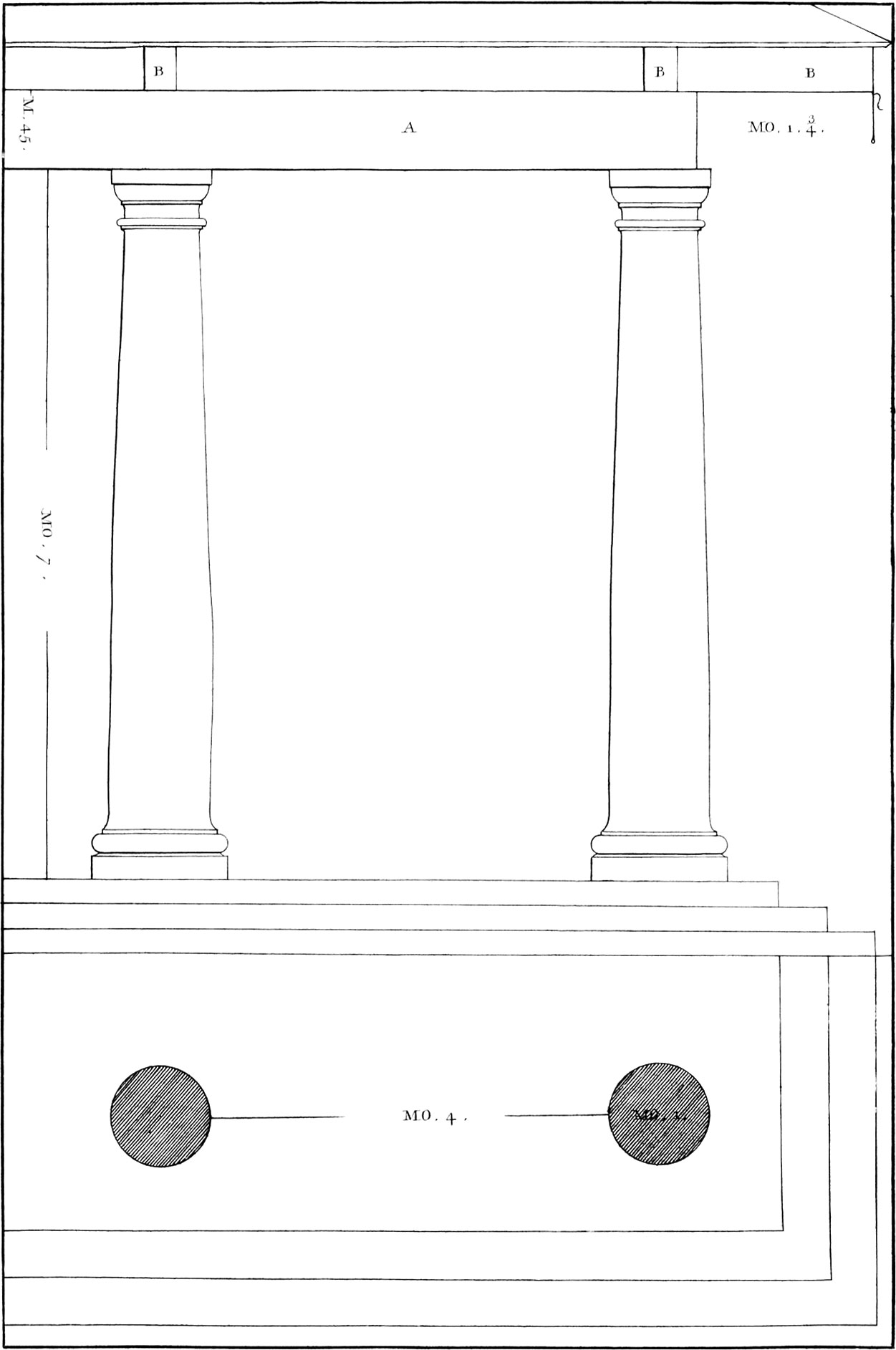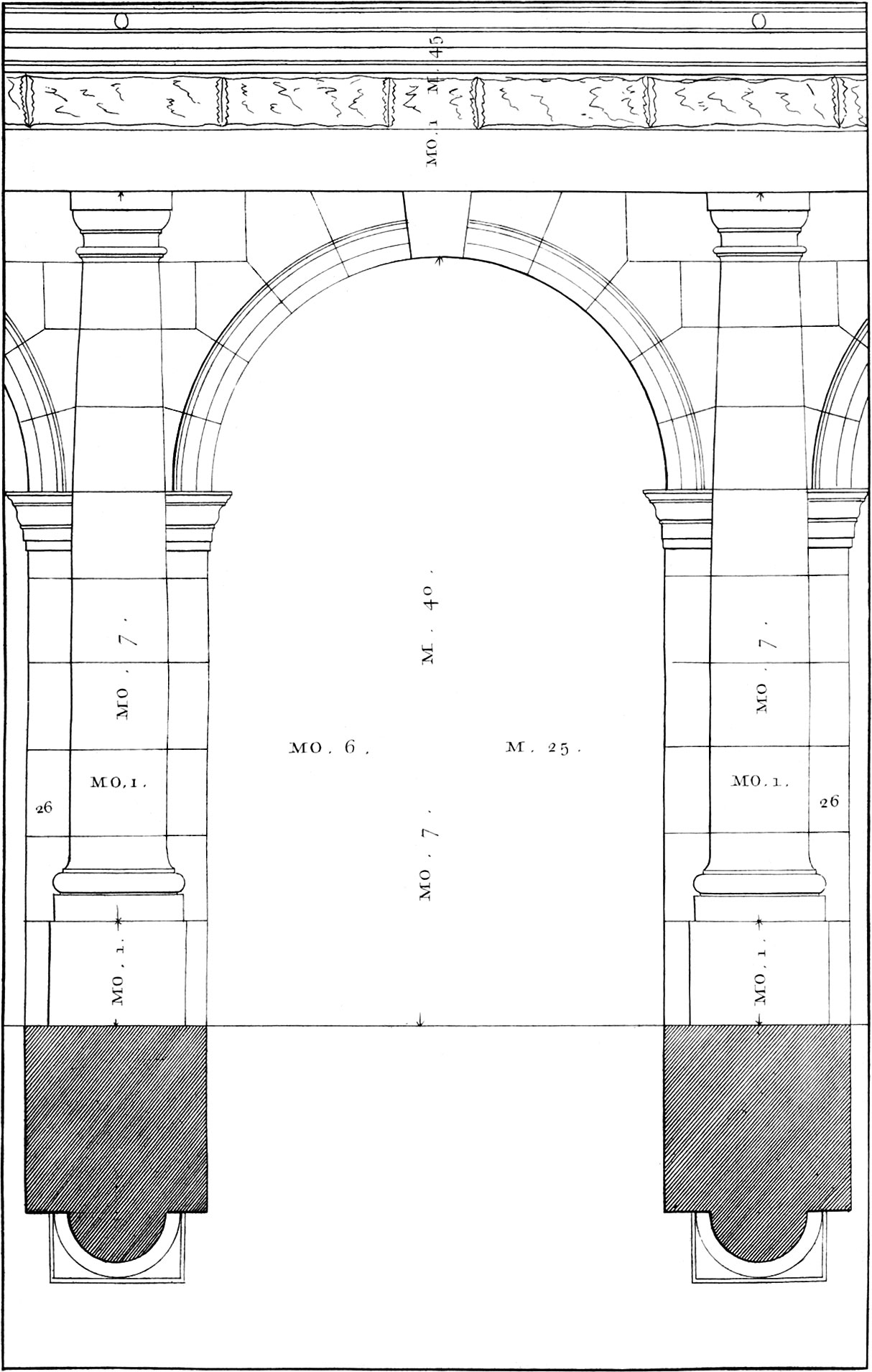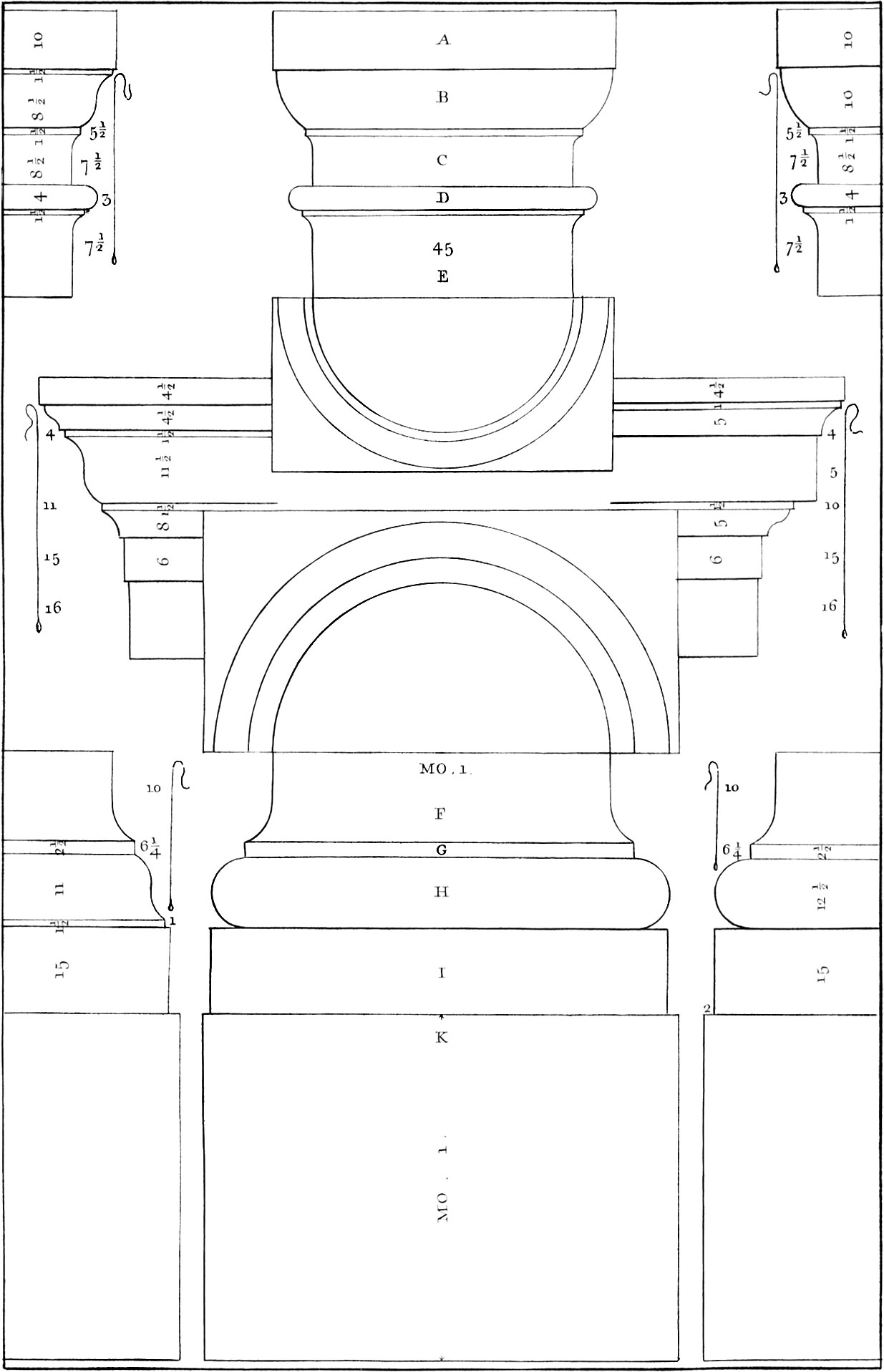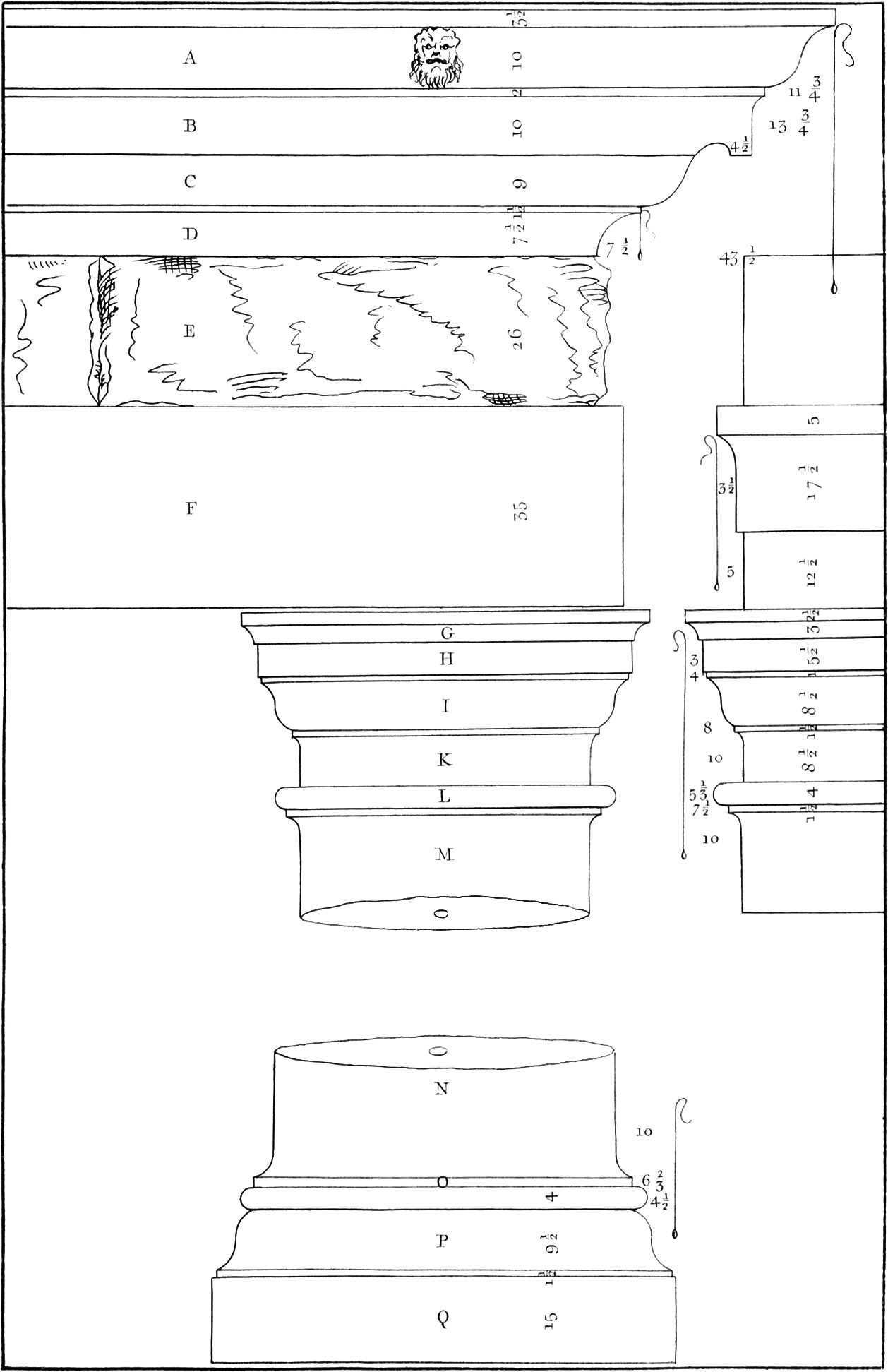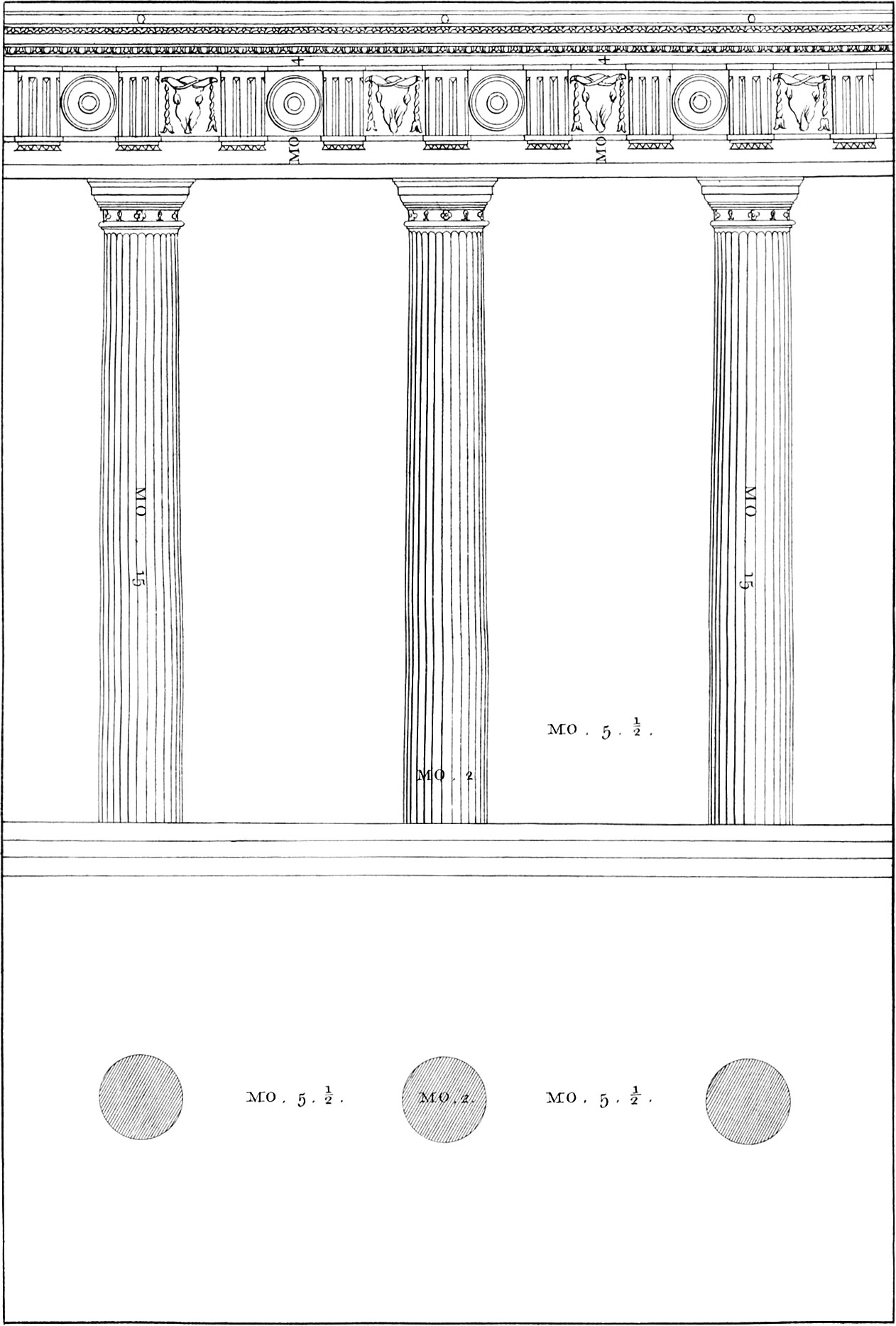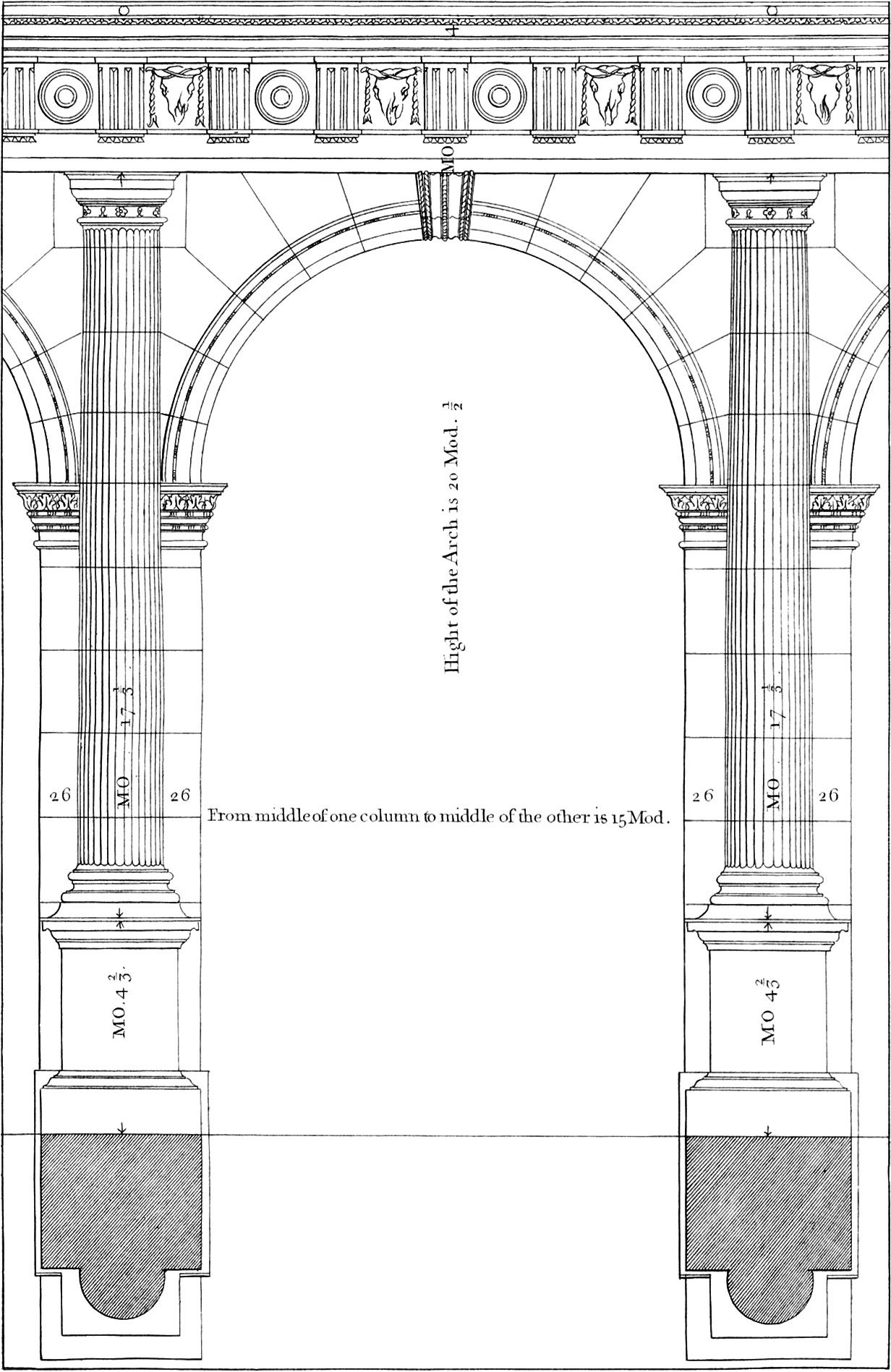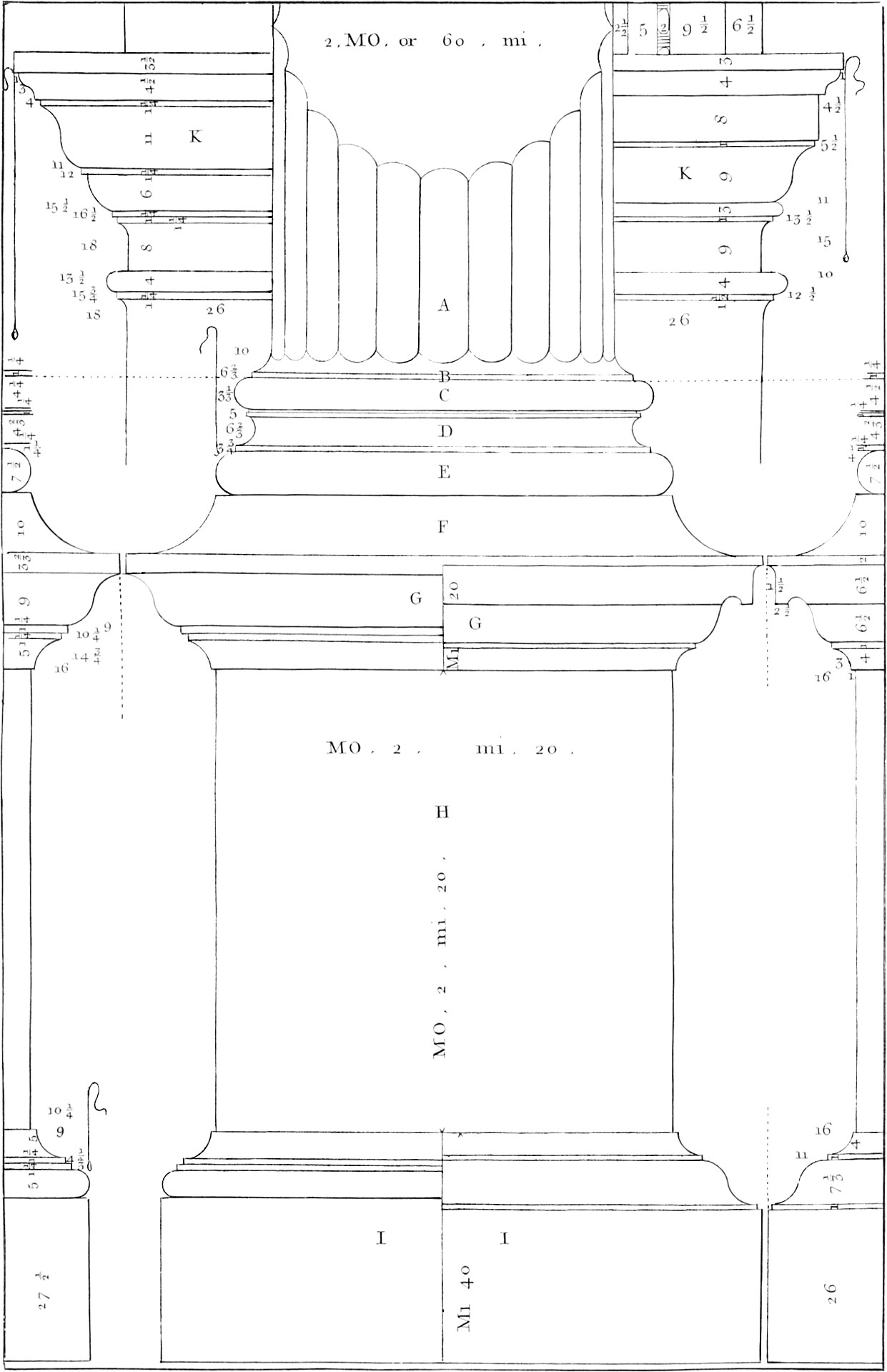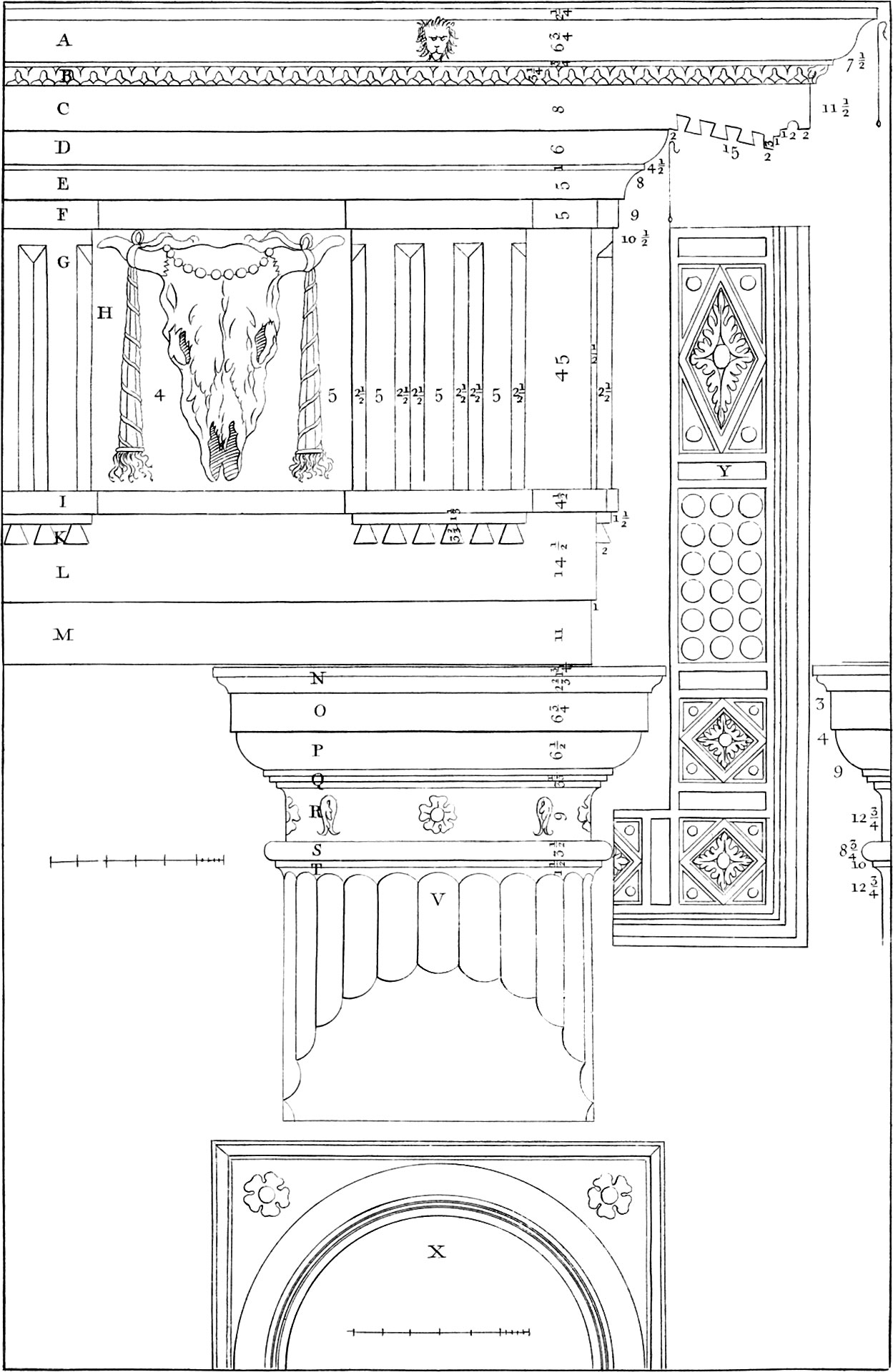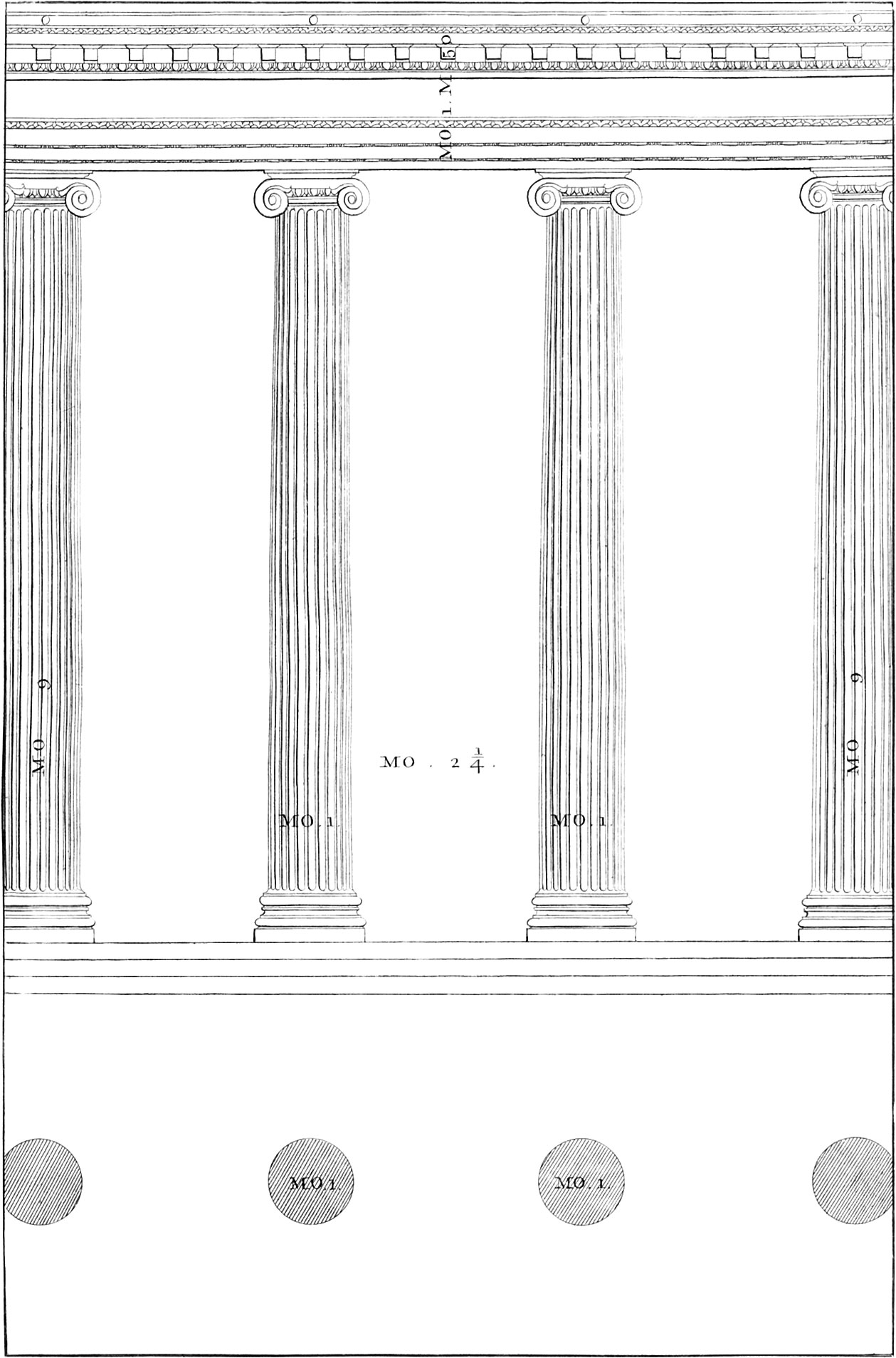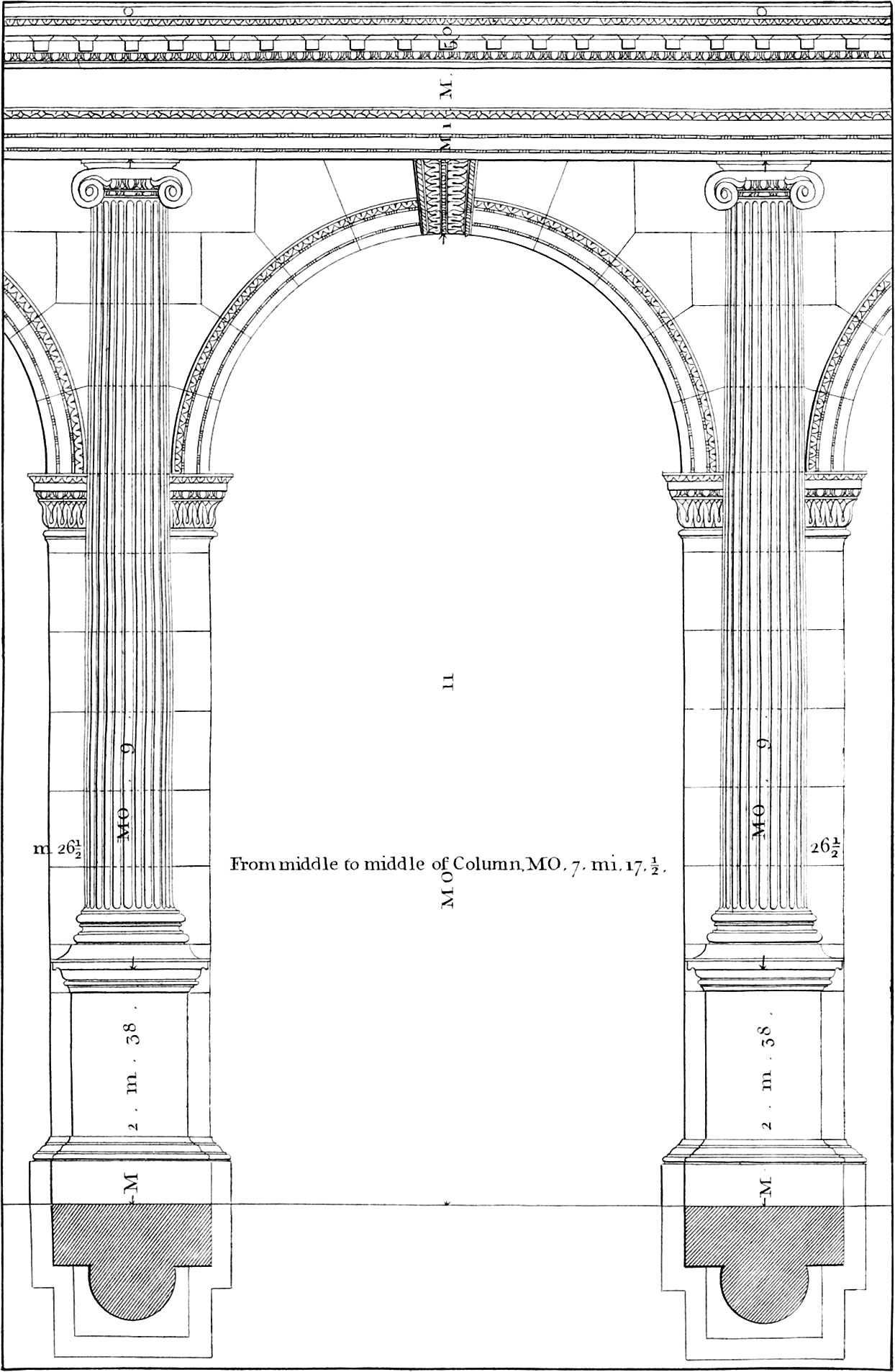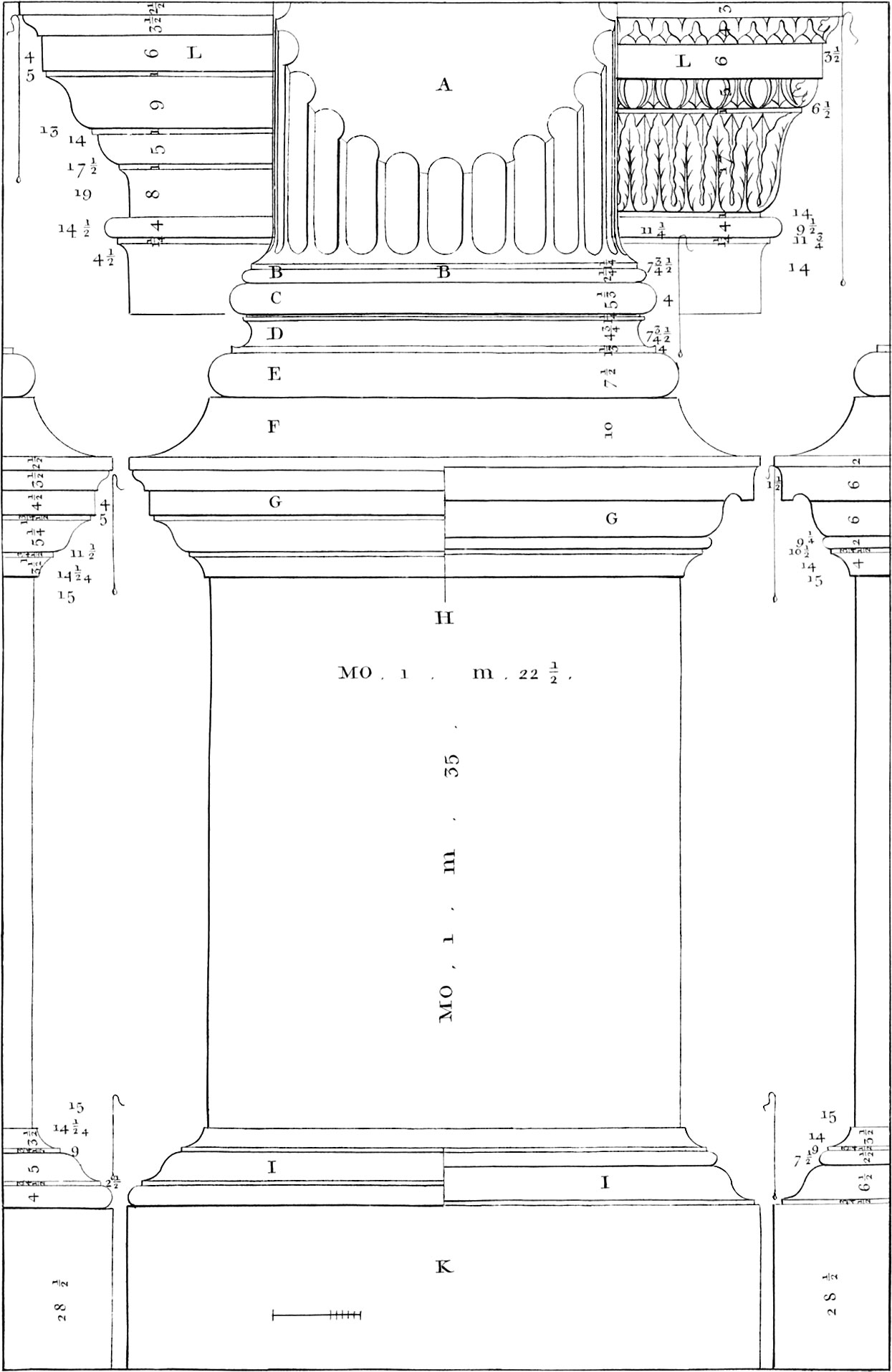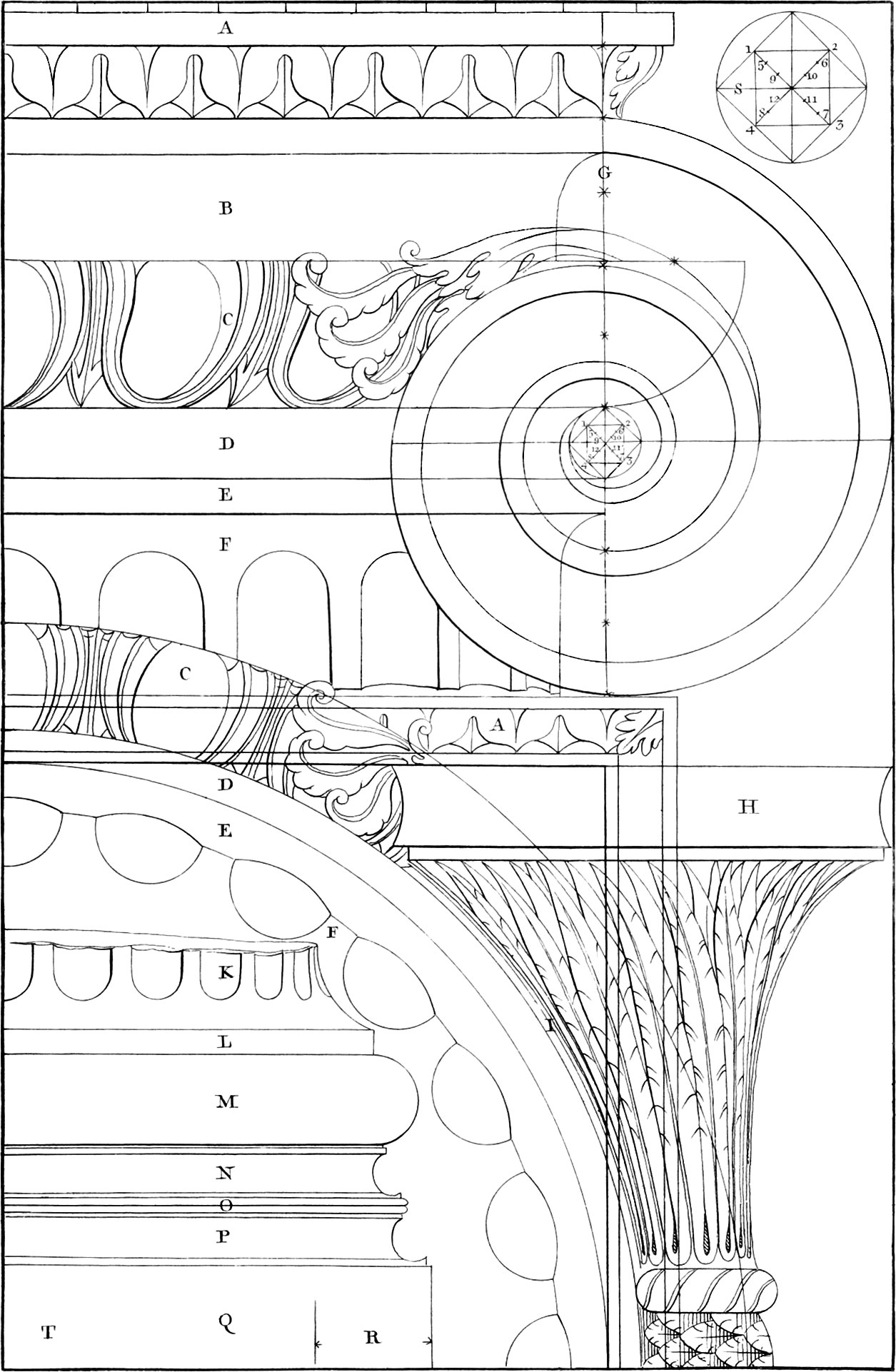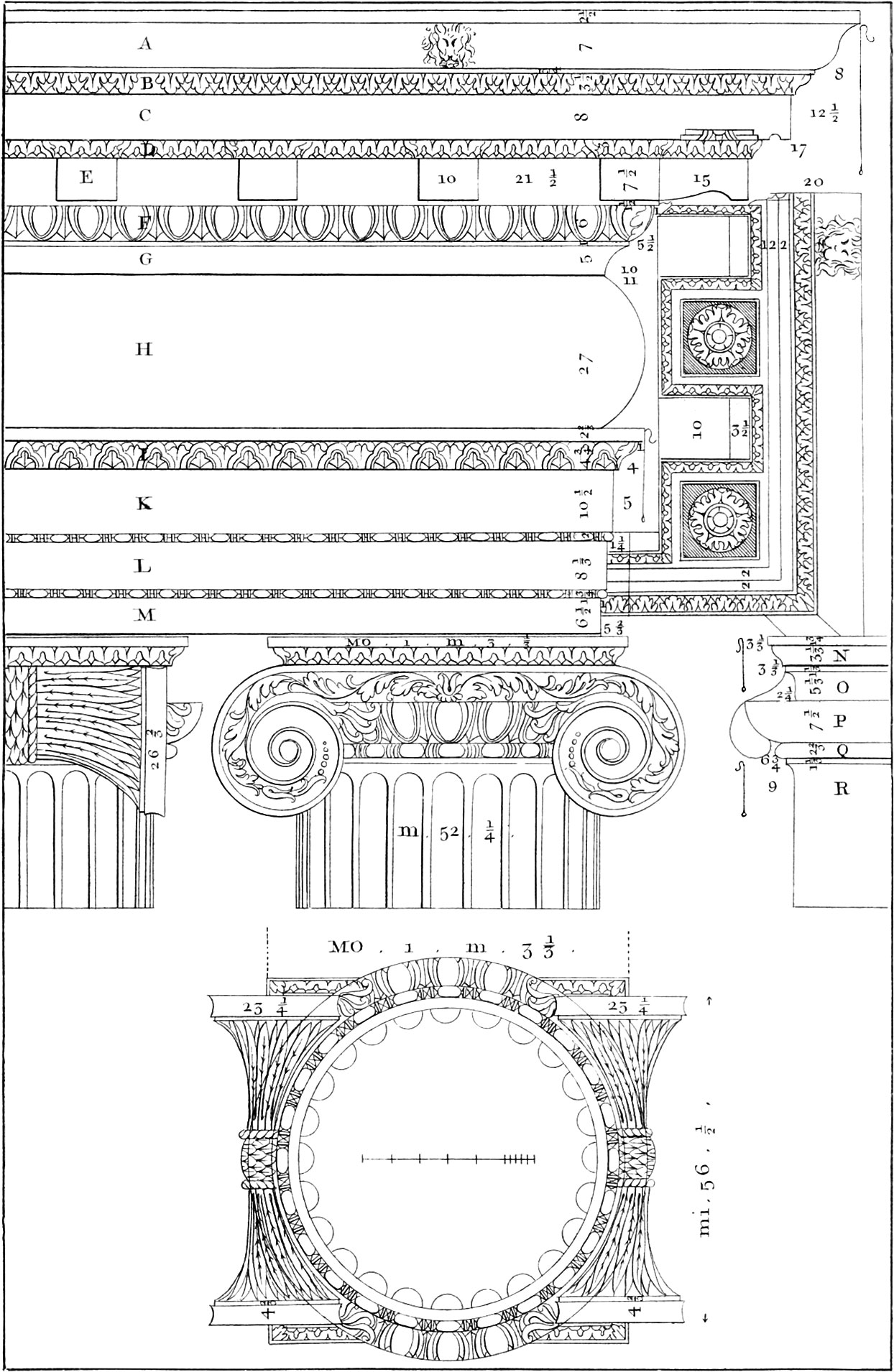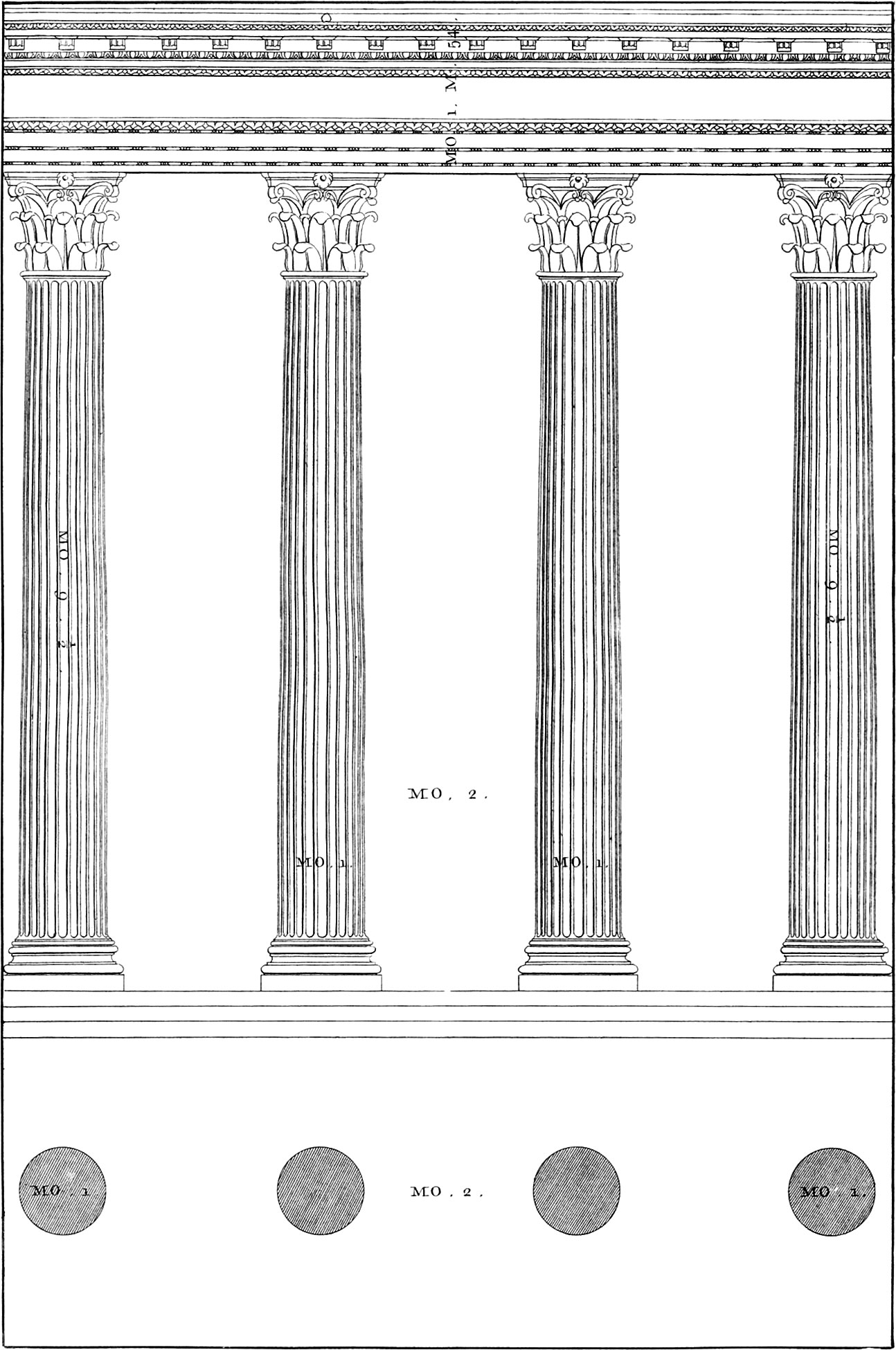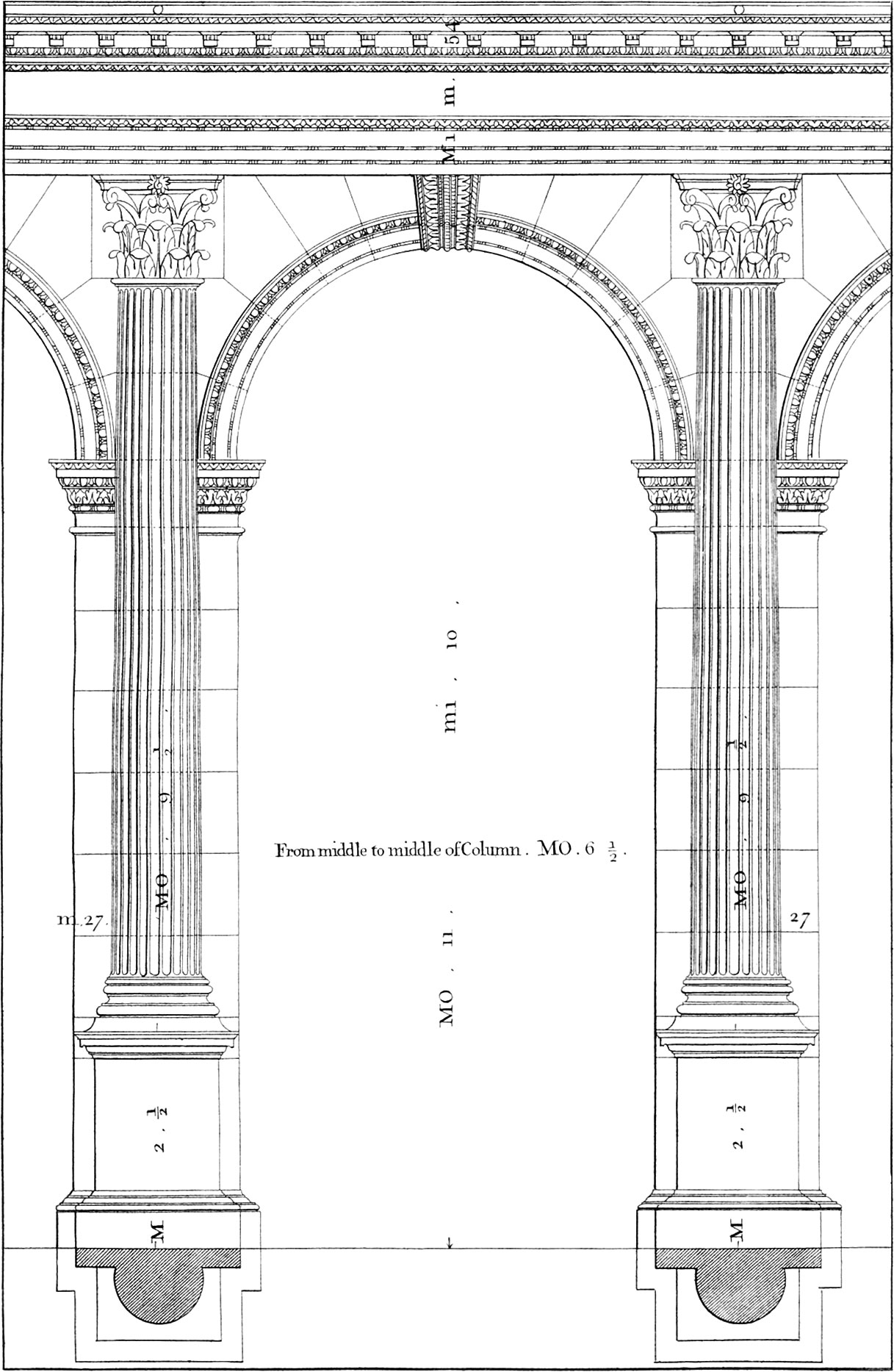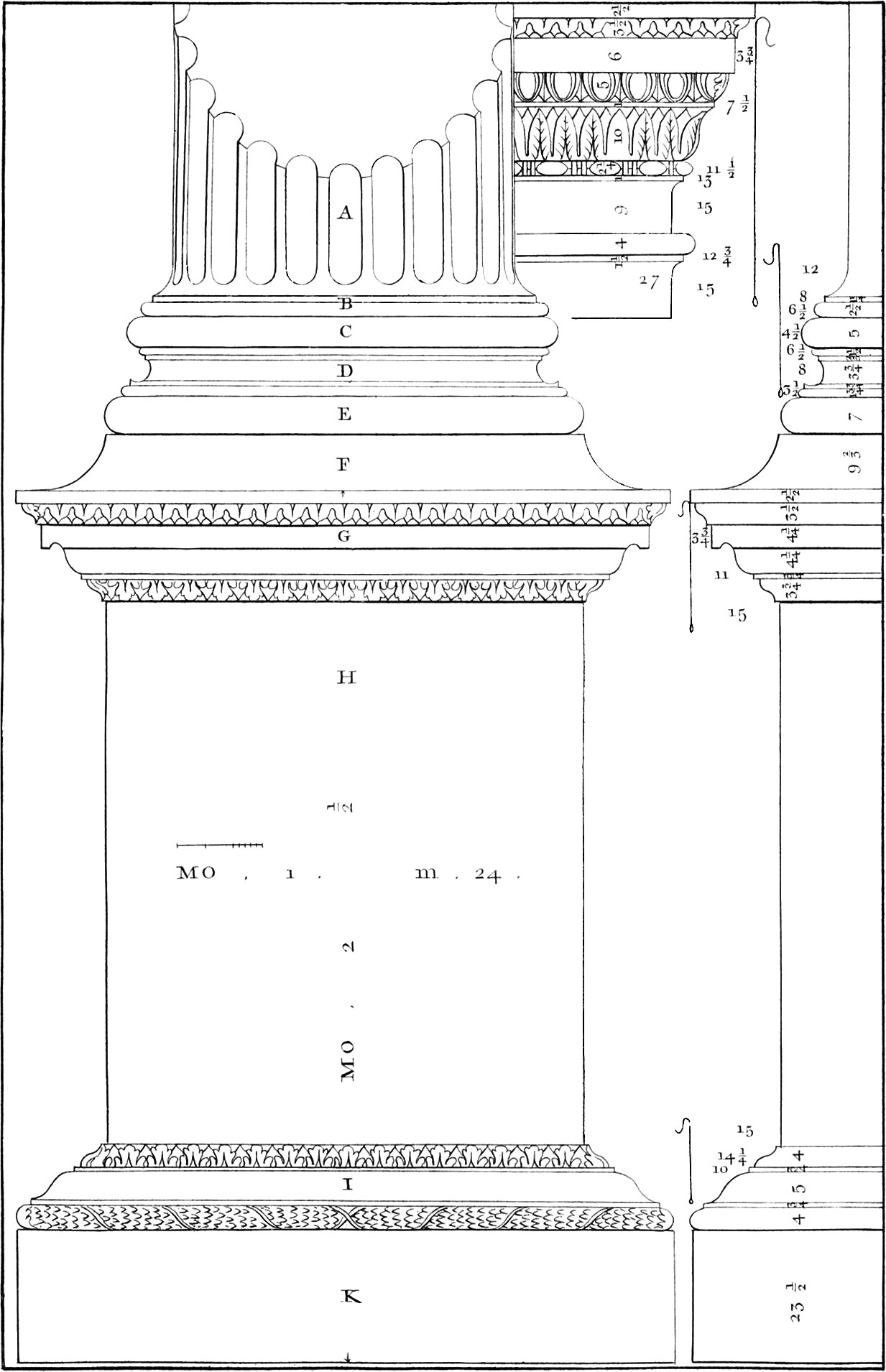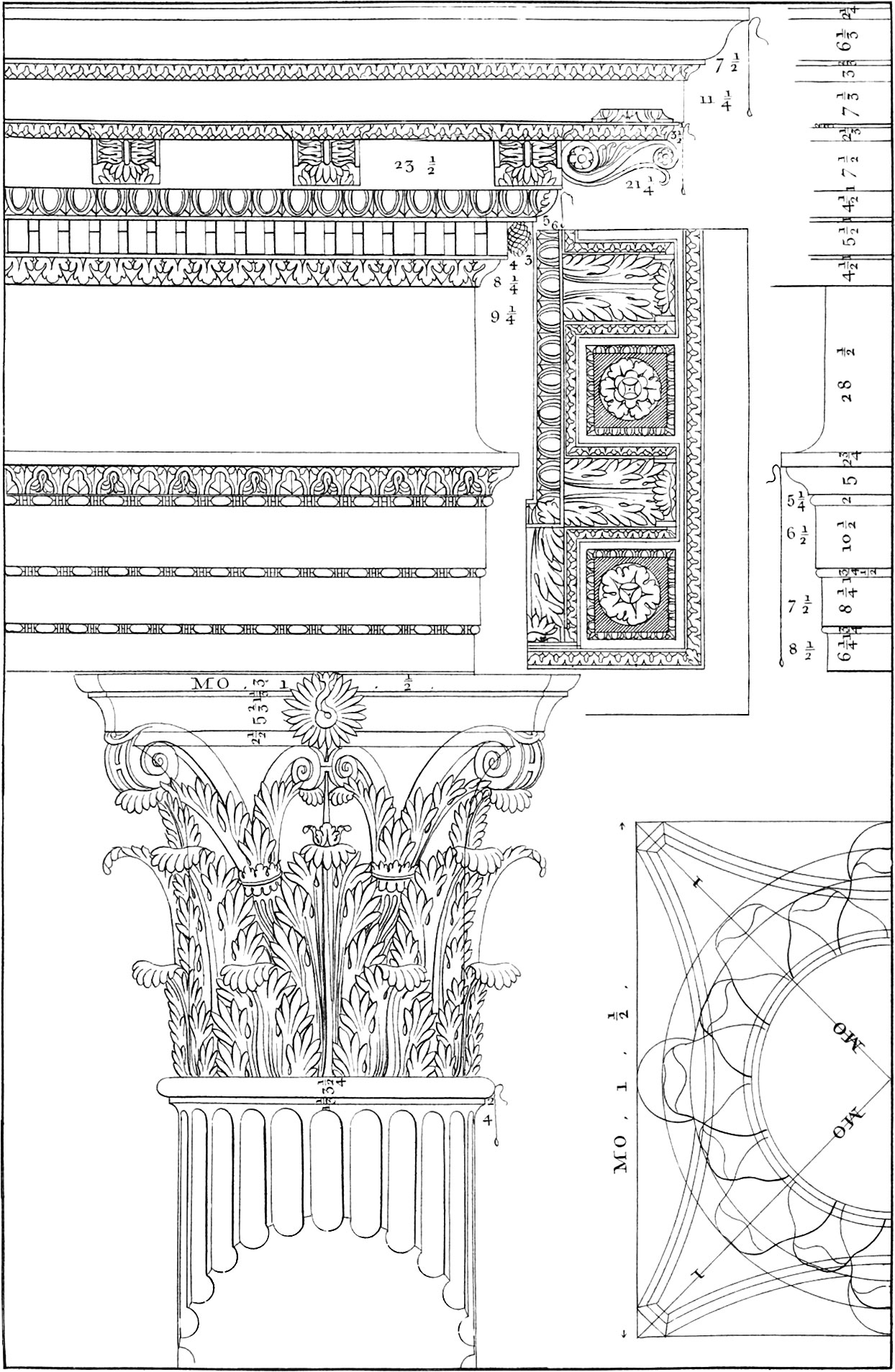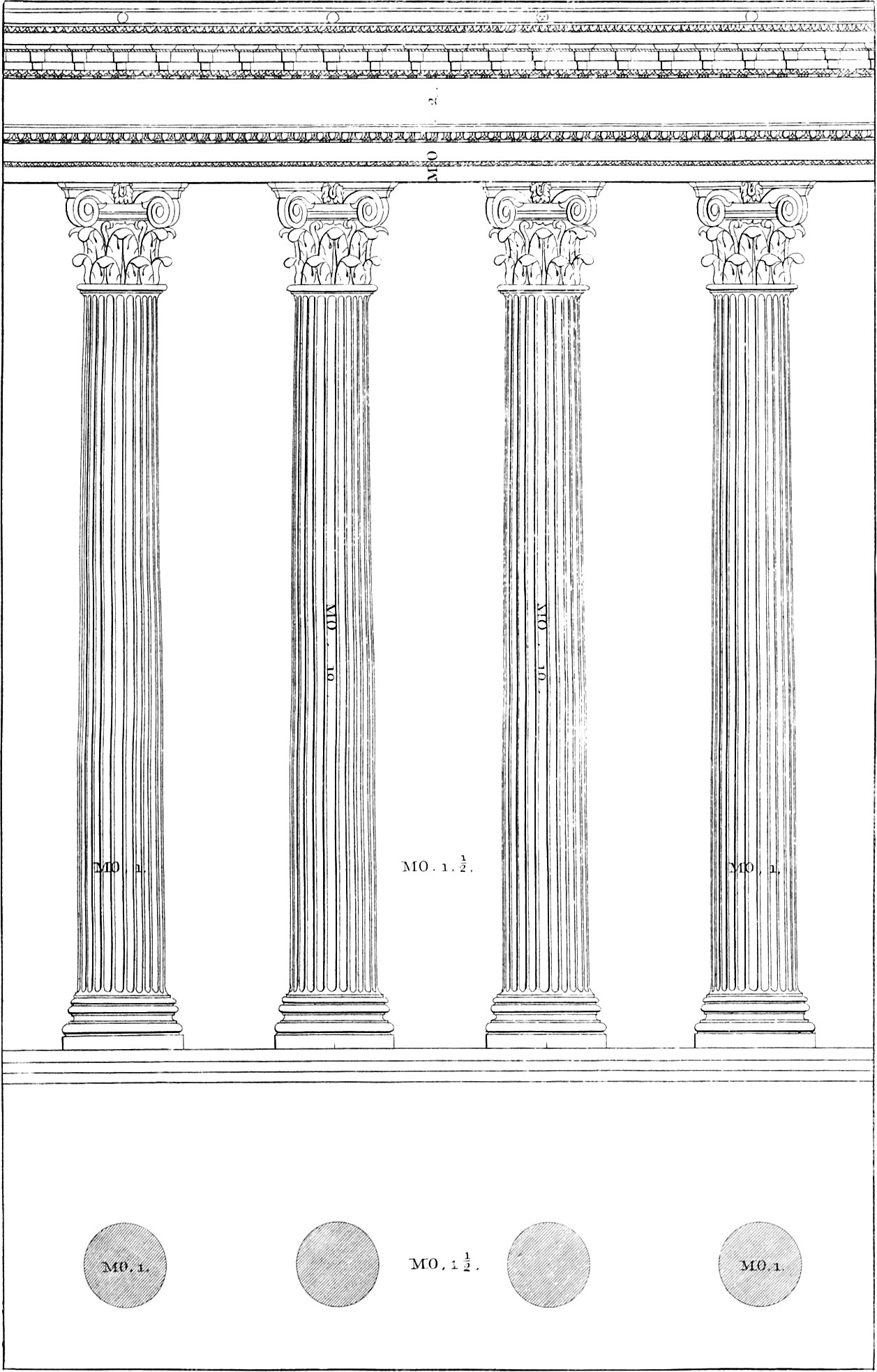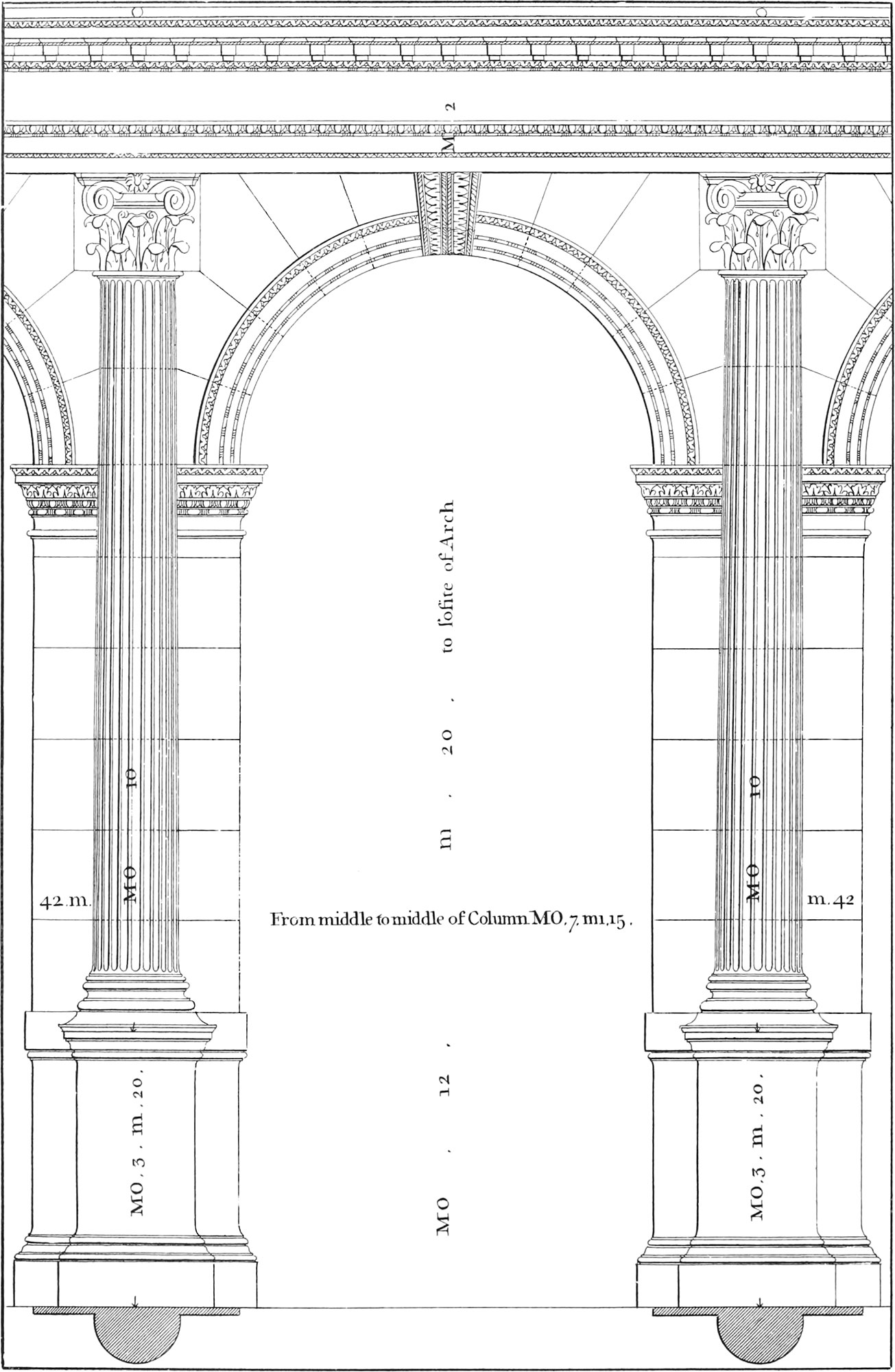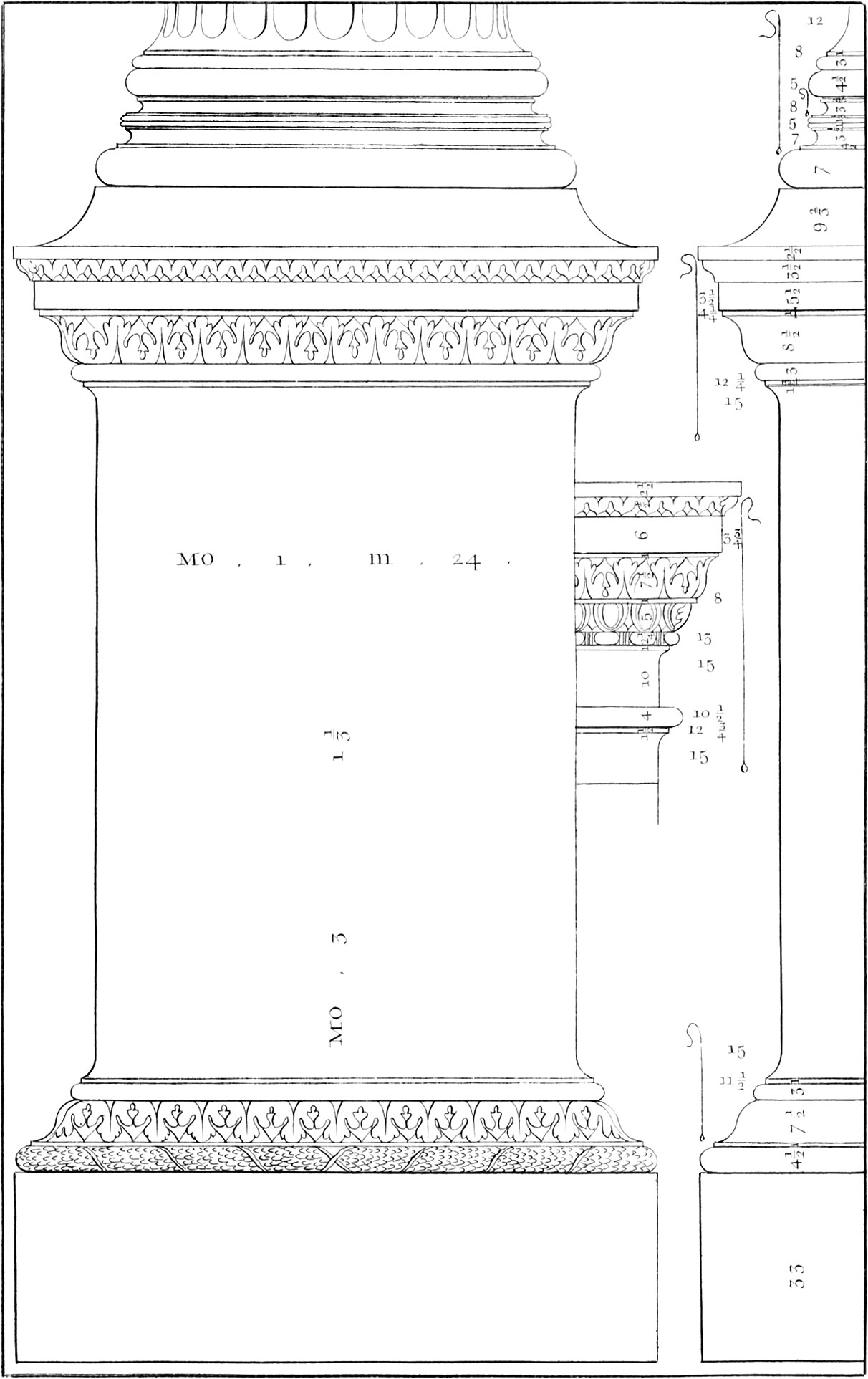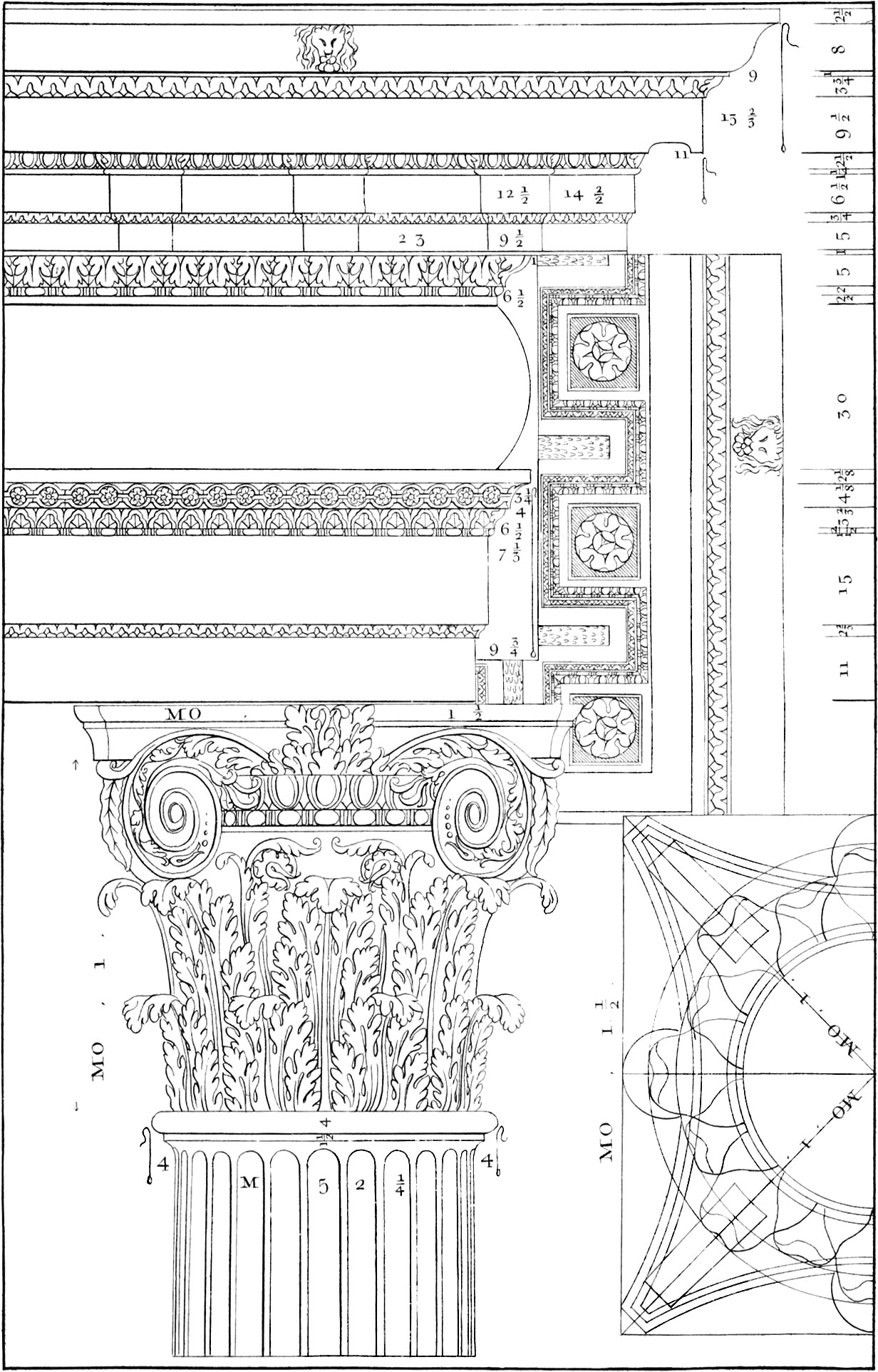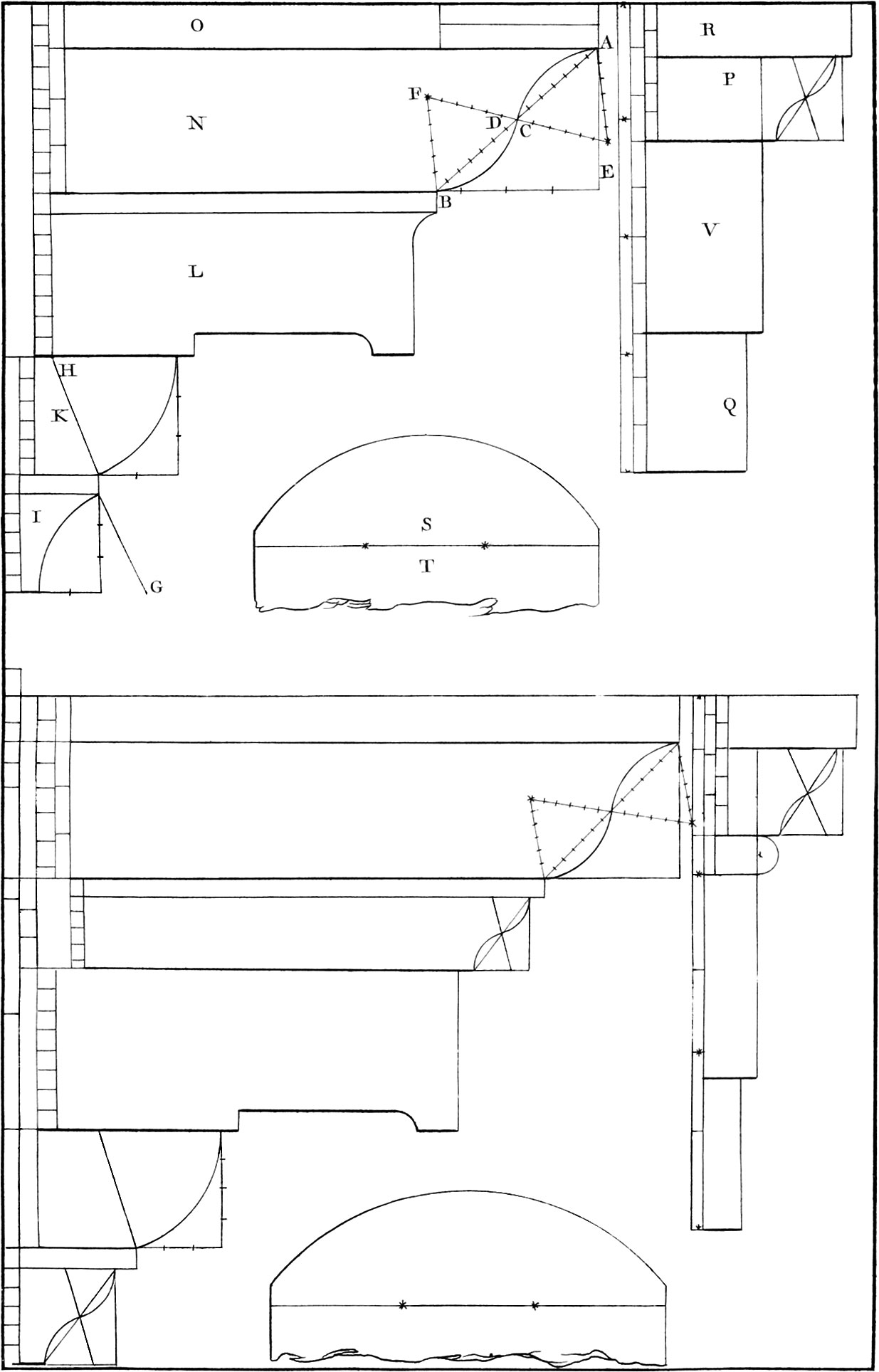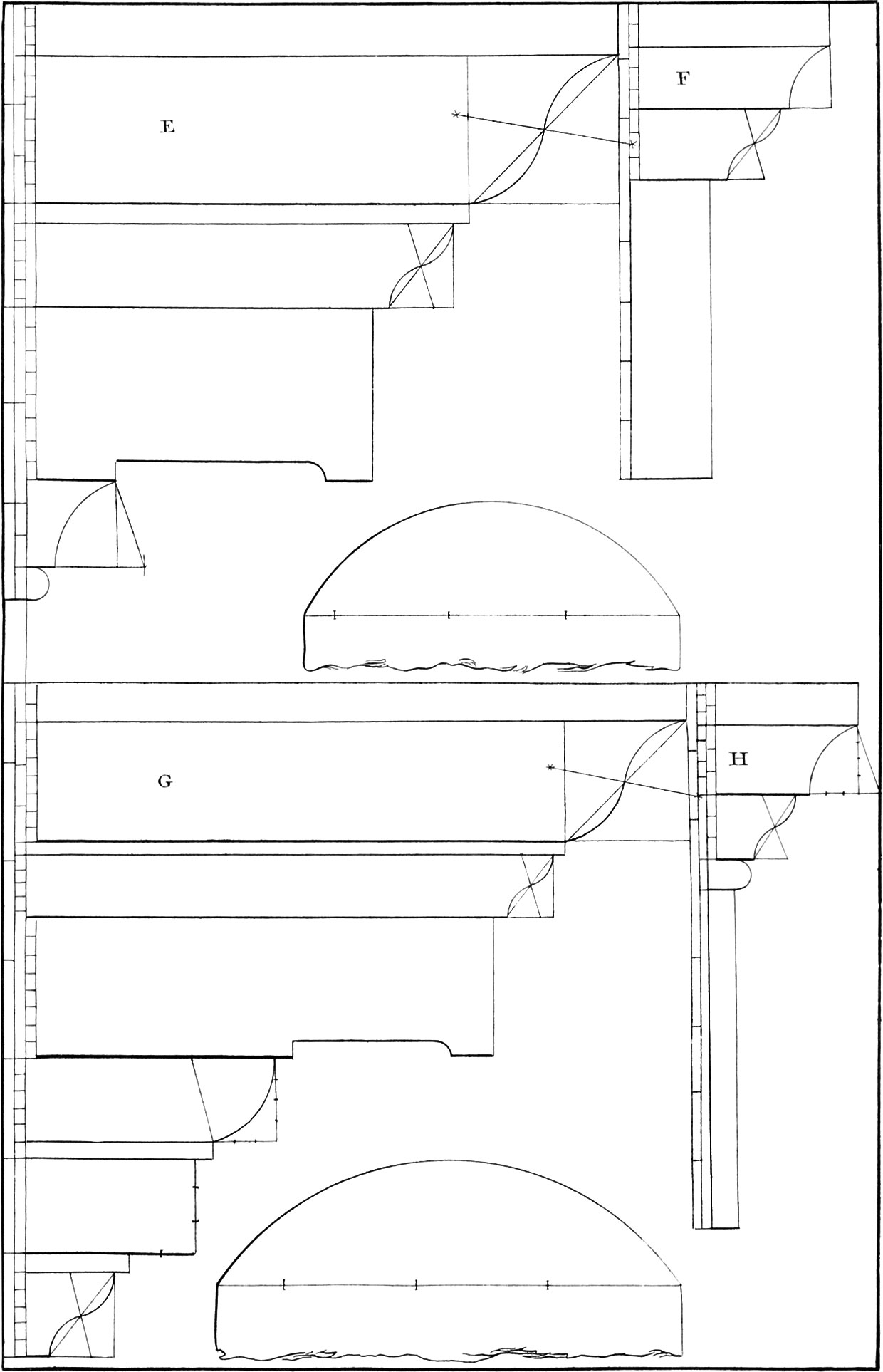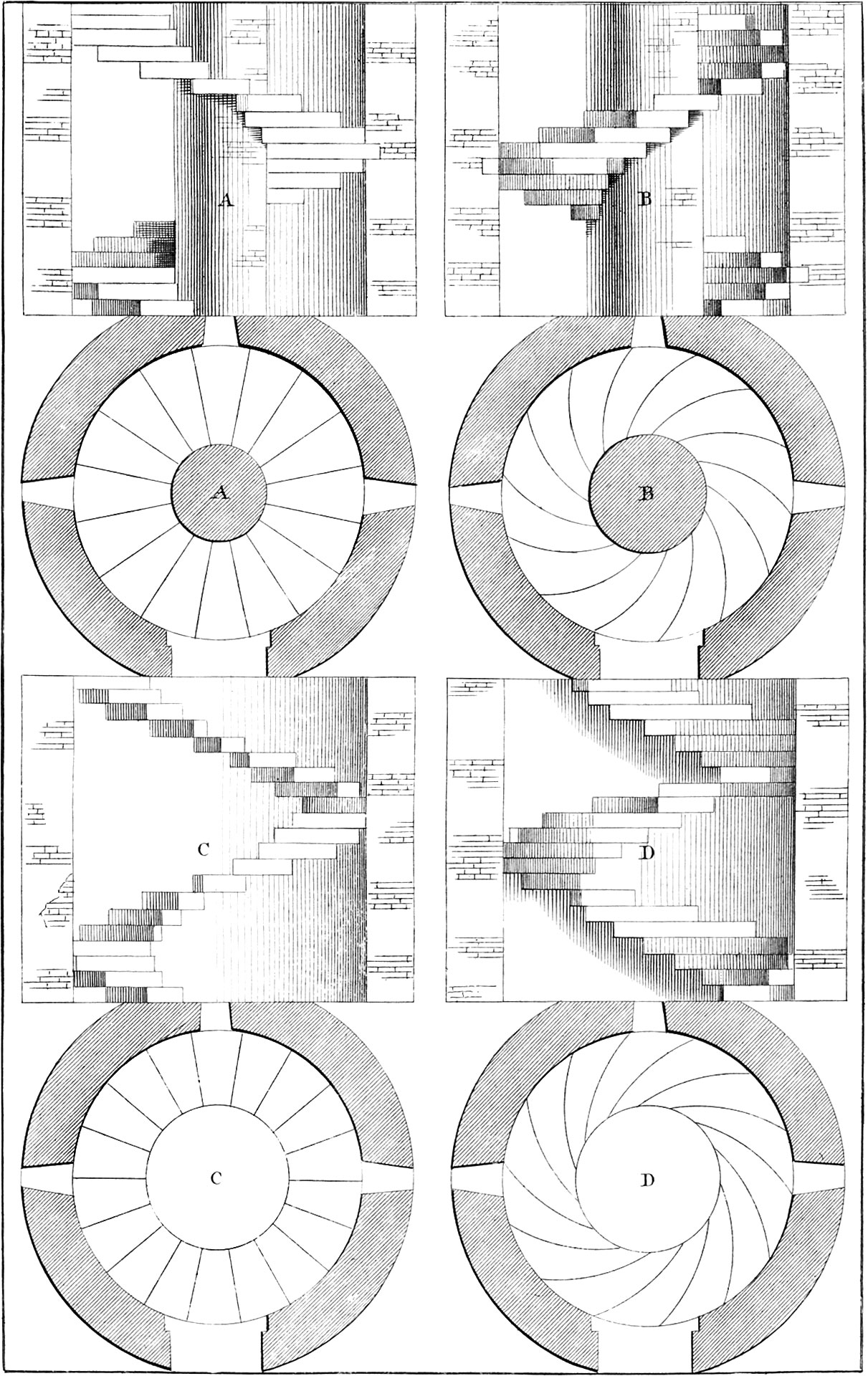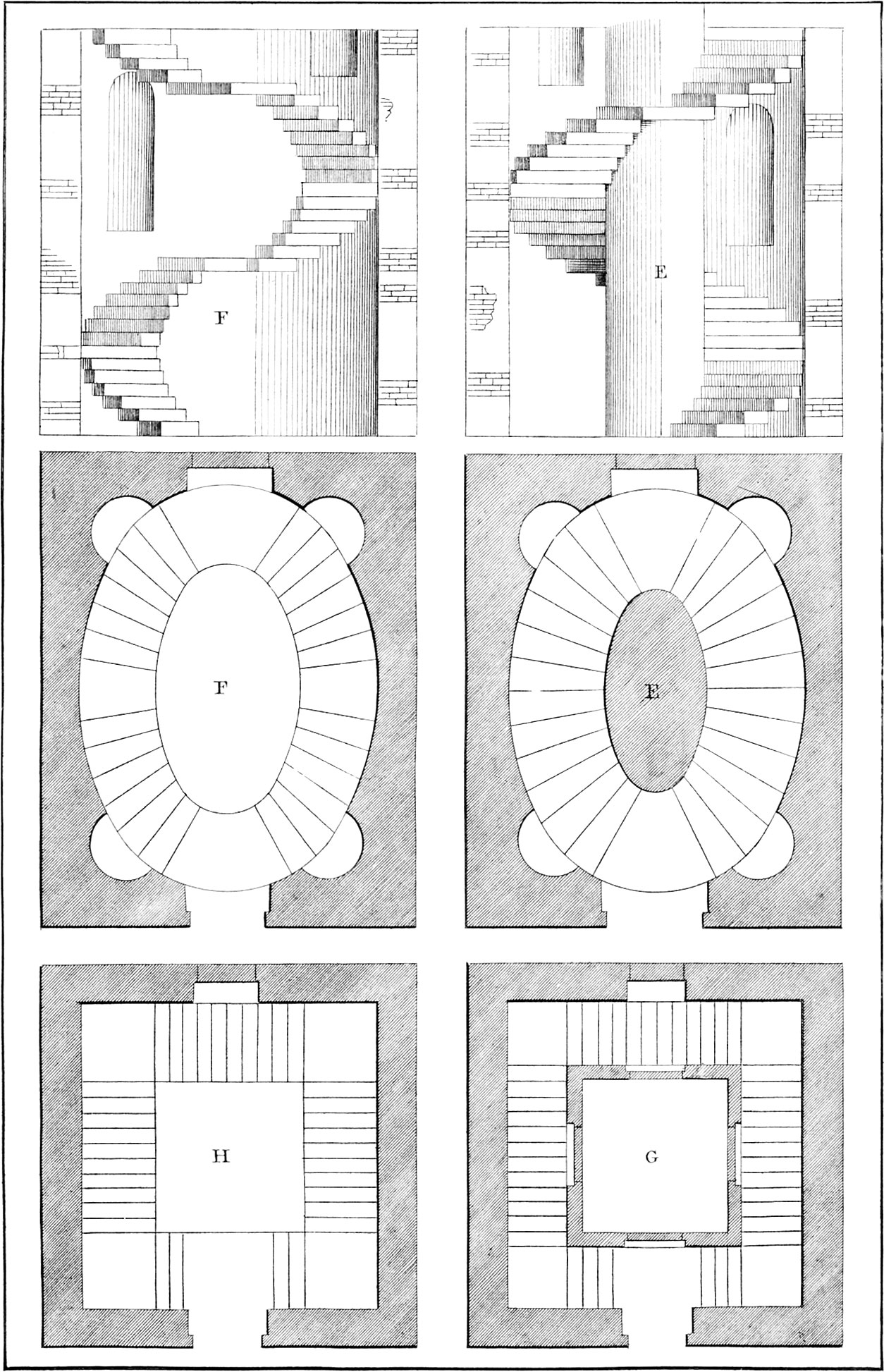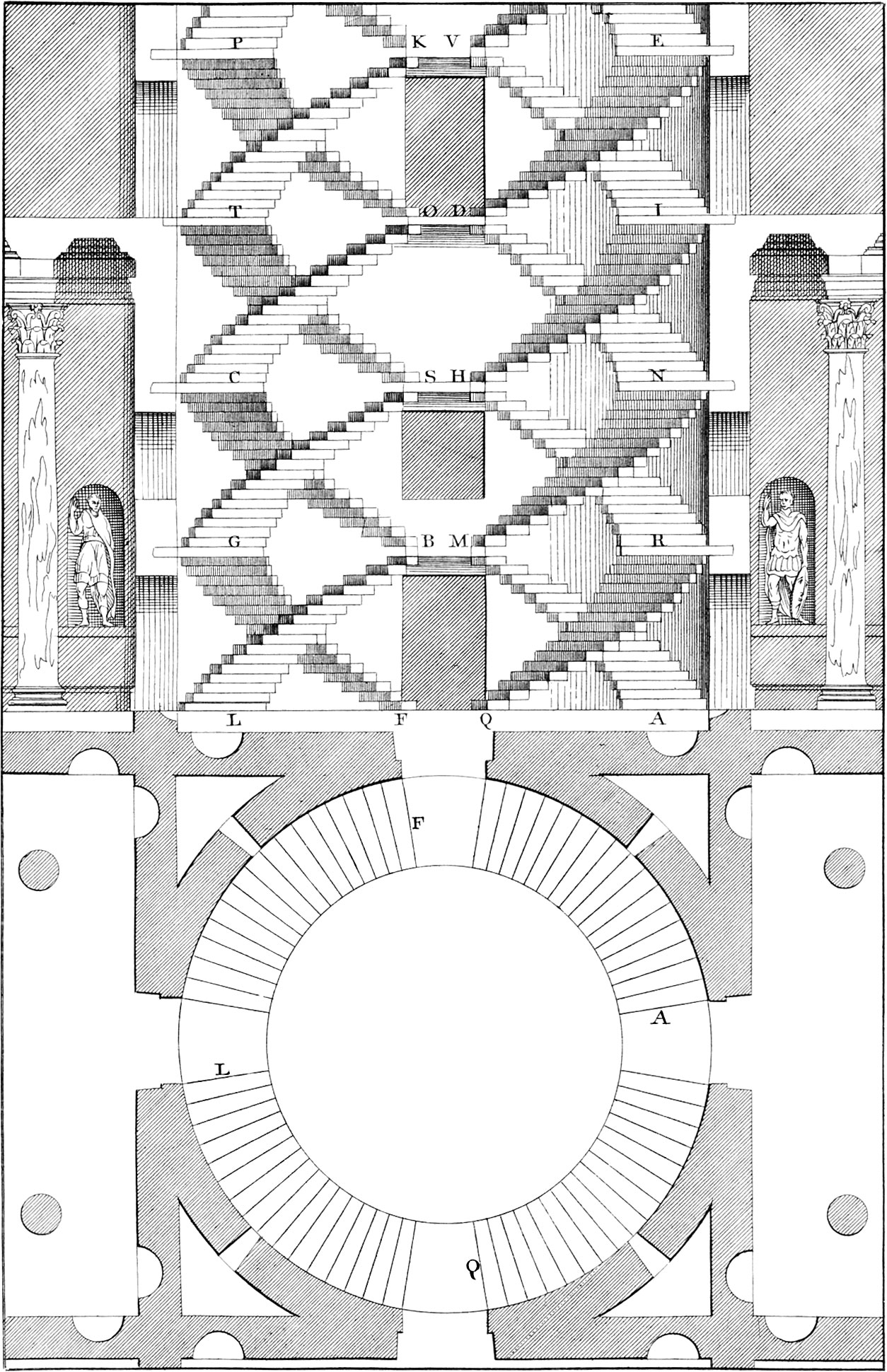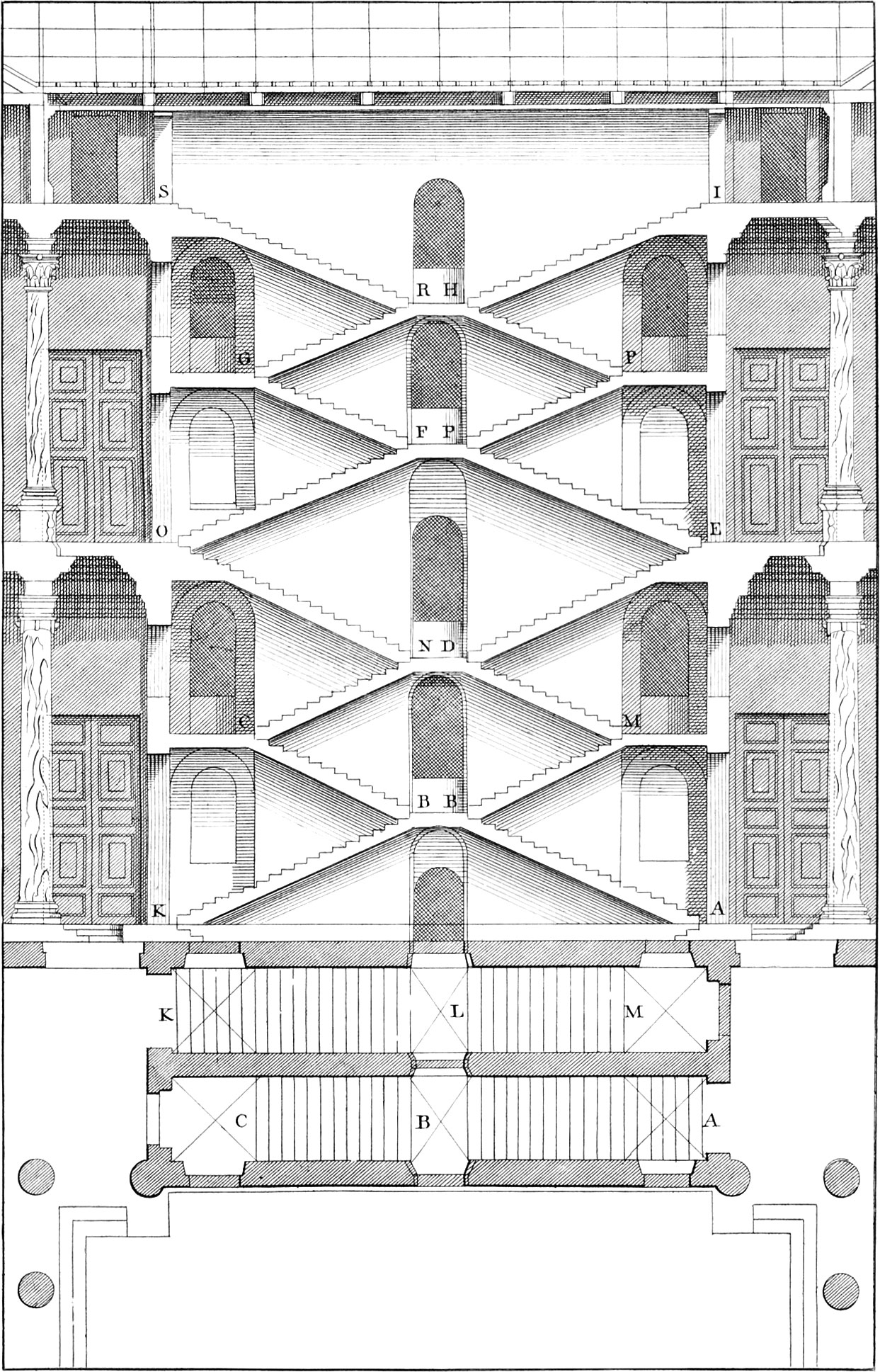Book I The Five Orders & Observations in Building
Chapter I Of the several particulars that ought to be considered and prepared before we begin to build
Great care ought to be taken, before building is begun, of the several parts of the plan and elevation of the whole edifice intended to be raised: For three things, according to Vitruvius, ought to be considered in every fabric, without which no evidence, duration and beauty. That will therefore cannot be called perfect, which should be useful and not durable, or durable and not useful, or having both these should be without beauty.
An edifice may be esteemed commodious, when every part or member stands in its due place and fit situation, neither above or below dignity and use; or when the loggia’s, halls, chambers, cellars and granaries are conveniently disposed, and in their proper places.
The strength, or duration, depends upon the walls being carried directly upright, thicker below than above, and their foundations strong and solid: observing to place the upper columns directly perpendicular over those that are underneath, and the openings of the doors and windows exactly over one another; so that the solid be upon the solid, and the void over the void.
Beauty will result from the form and correspondence of the whole, with respect to the several parts, of the parts with regard to each other, and of these again to the whole; that the structure may appear an entire and complete body, wherein each member agrees with the other, and all necessary to compose what you intend to form.
When those several particulars have been duly examined upon the model or draught, then an exact calculation ought to be made of the whole expense, and a timely provision made of the money, and of those materials that shall seem most necessary, to the end that nothing may be wanting, or prevent the completing of the work. In so doing, the builder will not only be commended; but it will also be of the utmost advantage to the whole structure, if the walls are equally and expeditiously carried up: for being thus dispatched, they will settle proportionably, everywhere alike, and not be subject to those clefts so commonly found in buildings that have been finished at diverse times.
Therefore, having made the choice of the most skillful artists that can be had, by whose advice the work may the more judiciously be carried on, you must then provide a sufficient quantity of timber, stone, sand, lime and metals; concerning which provision I intend to lay down some very useful directions. There must also be a sufficient number of joists, to frame the floors of the halls and chambers; which ought to be disposed and placed in such a manner, that the distance betwixt each joist may be the width of one joist and an half when they are framed together.
You must likewise observe, that when the jambs of doors and windows are to be made, not to choose stones bigger than a fifth, or less than a sixth part of the void or opening. And if you intend to adorn the building with columns or pilasters, make the bases, capitals, and architraves of stones, and the other parts of brick.
With respect to the walls, care must be taken, as they are raised, that they may proportionably be diminished in the thickness. Which observation, if rightly applied, may be of singular service, and enable you to make a truer estimate of the charge, and avoid great part of the expense.
But as I shall treat more distinctly of these several particulars under their respective heads, this general hint may suffice at present, and may serve as a sketch of the whole fabric.
The same regard is likewise to be had to the quality and goodness of those materials, that the best may be chosen. The experience gained from the buildings of the others, will very much help to determine what is fit and expedient to be done.
And although Vitruvius, Leon Baptista Alberti, and other excellent writers, have laid down very useful rules with respect to the choice of the materials, I shall nevertheless take notice of such as are most essential, that nothing may appear to be wanting in this treatise.
Chapter II Of Timber
Vitruvius tells us, in the ninth chapter of his second book, that timber ought to be felled in autumn, or during the winter season, in the wane of the moon; for then the trees recover the vigor and solidity that in spring and summer was dispersed among their leaves and fruit. It will, moreover, be free from a certain moisture, and very apt to engender worms, and rot it, which at that time will be consumed and dried up. It ought likewise to be cut but to the middle of the pith, and so left until it is thoroughly dry, that the moisture, the cause of putrefaction, may gradually distill and drop away.
When felled, it must be laid in a proper place, where it may be sheltered from the south sun, high winds, and rain. That of a spontaneous growth especially ought to be fully dried, and daubed over with cow-dung, to prevent its splitting. It should not be drawn through the dew, but removed rather in the afternoon; nor wrought when wet and damp, or very dry: the one being apt to cause rottenness, and the other to make clumsy work. Neither will it in less than three years be dry enough to be made use of in planks for the floors, windows, and doors.
Those therefore who are about to build, ought to be informed from men thoroughly acquainted with the nature of timber, that they may know which is fit for such and such uses, and which not.
In the above-mentioned chapter Vitruvius gives many other useful directions, besides what other learned men have written upon that subject.
Chapter III Of Stones
Stones are either natural, or artificially made by the industry of men. The former are taken out of quarries, and serve to make lime (of which more hereafter) and also to raise walls. Those of which walls are commonly made, are marble and hard stone, also called live stone; or soft, and tender.
Marble and live stone ought to be wrought as soon as they are taken out of the quarry, which then may be done with much more ease than after they have continued some time exposed to the air. But the softer kind must be dug in summer, and placed under a proper shelter for the space of two years before they are used, that they may more gradually harden, being thus defended from high winds, rain, and frosts (especially when the nature of the stone is not well known, or if it be dug out of a place that never was opened before) by which means they will be made much fitter to resist the inclemencies of the weather.
The reason for keeping them so long is, that being sorted, those which have received damage, may be placed in the foundations; and the others, which have not been injured, should be used above the ground: and thus they will last a long time.
The stones artificially made are commonly called quadrelli, or bricks, from their shape. These ought to be made of a chalky, whitish, and soft earth, dug up in autumn, and tempered in winter, that, in the spring following, it may be the more conveniently be worked up into bricks; always avoiding that earth that is over fat or sandy. But if necessity obliges to make them in the winter or summer time, they must carefully be covered during the former season with dry sand, and in the latter with straw. When made, they require a long time to dry; for which reason a good shelter is the most proper place, to cause the outside and inside to dry or harden equally, which can’t be accomplished in less than two years.
And as bricks are made either larger or smaller, according to the quality of the building, and their intended use; so the ancients made them larger for public and great buildings than for small and private ones; and therefore holes ought to be made here and there through the larger, that they may dry and burn the better.
Chapter IV Of Sand
There are three sorts of sand commonly found; pit, river, and sea sand. The best of all is pit sand, and is either black, white, red, or ash-colored; which last is a kind of earth calcined by subterraneous fires pent up in the mountains, and taken out of pits in Tuscany.
They also dig out of the earth in Terra di Lavoro, in the territories of Baia and Cuma, a sort of sand, called Pozzolana Vitruvius, which immediately cements in the water, and makes buildings very strong. But long experience has shown, that of all the several kinds of pit sand, the white is the worst. The best river sand is that which is found in rapid streams, and under waterfalls, because it is most purged. Sea sand, although the worst, ought to be of a blackish color, and shine like glass: that which is large grained, and nearest to the shore, is best. Pit sand, being fattest, makes, for that reason, the most tenacious cement, and is therefore employed in walls and long vaults; but it is apt to check.
River sand is very fit for covering and rough-casting of walls. Sea sand soon wets and soon dries, and wastes by reason of its salt, which makes it very unfit to sustain any considerable weight.
Every kind of sand will be good that feels crisp when handled, and, if laid upon white clothes, will either stain or leave earth behind it. But that sand is bad, which, being mixed with water, makes it turbid and dirty: As also such as has remained a long while exposed to the weather; for then it will contained so much earth and corrupt moisture, that it will be apt to produce shrubs and wild fig-trees, which are very prejudicial to buildings.
Chapter V Of Lime, and of the method of working it into mortar
The stones of which lime is made, are either dug out of hills, or taken out of rivers. All those taken out of hills are good where dry, brittle, free from moisture, or the mixture of any substance, which being consumed by the fire, diminishes the stone. That lime will therefore be best which is made of the most hard, solid, white stone, and which, being burned, is left a third part lighter than the stone of which it was made.
There is also a spongy sort of stone, the lime of which is very good for covering and rough-casting of walls; likewise a scaly rugged stone, taken out of the hills of Padua, that makes an excellent lime for such buildings as are most exposed to the weather, or stand under water, because it immediately sets, grows hard, and is very lasting.
All stones taken out of the earth are much better to make lime of, than those which are collected; and rather taken from a shady moist pit, than from a dry one. The white are better than the brown, as being the most easily worked. The pebbles found in rivers and rapid streams, are excellent for lime, and make very white neat work; therefore it is chiefly used in the rough-casting of walls. All stones, either dug out of the hills or rivers, burn quicker or slower, in proportion to the fire given to them, but are generally calcined in sixty hours. When calcined, they must be wetted, in order to slack them; observing not to pour on the water all at once, but at several times, to prevent its burning before it be well-tempered, and afterwards must be laid in a moist shady place, only covering it lightly with sand, taking care not to mix anything with it; and when used, the more it is worked up with the sand, the better it will cement; except that made of scaly stone, like that from Padua, because that must be used as soon as it is slacked, to prevent its burning and consuming away; it will otherwise be useless.
To make mortar, lime should be mixed with sand in this proportion; three parts of pit sand to one of lime, but two of sea or river sand to one of lime.
Chapter VI Of Metals
The metals commonly employed in buildings, are iron, lead, and copper. Iron serves to make nails, hinges, bars, gates, bolts for fastenings, and such like works.
There is no iron anywhere found pure; nor any, when taken out of the earth, but must first be melted, and then purged of its dross by the fire, to make it fit for use. For then it will easily be made red-hot, will be soft enough to be wrought, and spread under the hammer: And if not well hammered when red-hot, it will burn and waste away.
It is a sign the iron is good, if, when reduced into bars, you see he veins run straight and uninterrupted, and that the ends of the bars be clean and without dross: From these veins will show that the iron is free from lumps and flaws; by the ends we may know the goodness of the middle; and, when wrought into square plates, or any other shape, if its sides are straight and even, we may conclude it is equally good in all its parts, as it has equally in every part endured the hammer.
Magnificent palaces, churches, towers, and other public edifices, are generally covered with lead. The pipes and gutters to convey the water, are also made of the same. It likewise serves to fasten the hinges and iron-work in the jambs of doors and windows. The three sorts of lead usually found, are the white, black, and that of a colour between both, by some called ash-coloured. The black is so called, not because it is really such, but because it is intermixed with some blackness; therefore the ancients, to distinguish it from the white, gave it very properly that name. The white is much more perfect, and of greater value than the black. And the ash-coloured holds the middle rank betwixt both.
Lead is either taken out of the earth in a great mass, without any mixture, or in small shining, blackish lumps; and is sometimes found sticking in small flakes to the rocks, to marble, and to stones. All the different sorts melt very easily, because the heat of the fire liquifies it before it can be made red-hot; and if thrown into an extreme hot furnace, it will not preserve its substance, but be converted into litharge and dross. Of the three sorts the black is the softest and most weighty, and therefore will easily spread under the hammer. The white is harder and lighter. The ash-coloured is much harder than the white, and is of a middle weight between both.
Public buildings are sometimes covered with copper; and the ancients also made nails and cramps thereof, which were fixed in the stone below, and to that above, to united and tie them together, and prevent them from being pushed out of their place. And by means of these nails and cramps, a building, which can’t possibly be made without a great number of pieces of stone, is so joined and fixed together, that it appears to be one entire piece, and for the same reason is much stronger and more durable.
These nails and cramps were likewise made of iron; but the ancients most commonly made them of copper, because it is less subject to rust, and consequently will last much longer. The Letters for inscriptions, that were placed in the friezes of buildings without, were made of copper; and history informs us, that the hundred famous gates of Babylon, and Hercules’ two pillars, eight cubits high, in the island of Gades, were also made of that metal.
The best and most excellent copper is that which is extracted and purged from the ore by the fire. If it is of a red colour, inclining to yellow, well-grained, and full of pores, we may then be pretty certain it is freed from dross.
Copper will heat red-hot in the fire, like iron, and so liquify that it may be cast. If thrown into an extreme hot furnace, it will not endure the flames, but totally consume and waste away. Although it be hard, it will nevertheless bear the hammer, and may be wrought into very thin plates. The best method to preserve it is to dip it into tar; for though it does not rust like iron, yet it has a peculiar rust, called verdigrease, especially if it be touched with any sharp liquor.
This metal mixed with tin, lead and brass (which last is only copper coloured with lapis calaminaris) makes bronze, or bel-metal, which is often used by architects in making bases, columns, capitals, statues, and such-like ornaments. There are to be seen in the church of St. Giovani Laterano in Rome four brass columns (one of which only has its capital) made by the order of Augustus of the metal that was found in the prows of those ships he had taken in Egypt from Mark Antony.
There also remains in Rome to this day four ancient gates, viz. the Rotunda, formerly the Pantheon; that of St. Adriano, formerly the temple of Saturn; that of St. Cosmo and St. Domiano, formerly the temple of Castor and Pollux, or rather of Romulus and Remus; and that of St. Agnas, now called St. Agness, without the gate Viminalis su la via Numenta.
The most beautiful of these is that of Santa Maria Rotunda; wherein the ancients endeavoured to imitate by art that sort of Corinthian metal in which the natural colour of gold did mostly predominate: For we read, when Corinth, now called Coranto, was burnt and destroyed, the gold, silver, and copper were melted and united into one mass, which was so tempered and mixed together, that it composed the three sorts of brass afterwards called Corinthian. In the first silver prevailed, of which it retained the whiteness and lustre; the second, as it partook more of the gold, retained mostly its yellow colour; the third was that in which all the three metals were pretty equally mixed. All these have afterwards been imitated by the various workmen.
Having sufficiently explained the several particulars and materials most necessary to be considered and prepared before we begin to build; it is proper, in the next place, to say something of the foundations, since it is from them the whole work must be raised.
Chapter VII Of the qualities of the ground where foundations ought to be laid
The foundations are properly called the basis of the fabrics, viz. that part of it under the ground which sustains the whole edifice above; and therefore of all the errors that can be committed in building, those made the foundation are most pernicious, because they at once occasion the ruin of the whole fabric, nor can they be rectified without the utmost difficulty. For which reason the architect should apply his utmost diligence in this point; inasuch as in some places there are natural foundations, and in other places art is required.
We have natural foundations when we build on a chalky foil, which in some degree resembles stone;1 for these, without digging or any other assistance from art, are of themselves very strong and sufficient foundations, and capable to sustain any great edifice, either on land or in water.
But when nature does not furnish foundations, when art must be made use of; because the places to build on are sometimes either solid ground, gravel, sand, or a moist and marshy soil. Where it is solid, the foundation need to be no deeper than what the quality of the building, and the solidity of the ground shall require (according as the judicious architect shall think proper) and must not exceed the sixth part of the height of the whole edifice, if there are no cellars or subterraneous offices wanted.
Observations made in digging of wells, cisterns, and such like, are of great use, and very much help us to know the solidity of the ground; as do also the herbs that spontaneously grow thereon, especially if they are such as spring up only in a hard and firm soil. The solidity may likewise be known by throwing a great weight upon the earth, provided it neither shakes or resounds (which may easily be observed by the help of a drum set upon the ground, if the percussion may gently moves it, without making it sound, or without moving the water in a vessel set near it:) It may also be judged of by the adjacent places.
But when the place is either sandy or gravelly, regard must be had whether it be on land or in the water. If it be on land, that only is to be observed which has before been said concerning dry ground. But if buildings are to be in rivers, the sand and gravel will be altogether useless; because the water, by its continual current and flood, is always shifting their bed: We must therefore dig until a firm and solid bottom be found. If that cannot easily be done, let some of the sand and gravel be taken out, and then piles, made of oak, must be driven in, until their ends reach the solid ground, upon which one may build.
But if a building is to be raised upon a boggy soil, then it must be dug out, until firm ground be come at, and so deep therein as is in proportion to the thickness of the walls, and the largeness of the fabric.
Sound and firm soils, fit to sustain buildings, are of various kinds: For as Alberti well observes, in some places the soil is so hard, that iron can scarce cut its way into it, and sometimes still harder; in others blackish or whitish, which is esteemed the weakest; some are like chalk, or otherwise soft; But the best is that which is cut with the most labour, and when wet does not dissolve into mud.
No buildings should be erected on ruins before their depth is first known, and weather they are sufficient to sustain the edifice.
When the ground is soft, and sinks very much, as it commonly does in bogs, then piles are to be used, whose length ought to be the eighth part of the height of the walls, and their thickness the twelfth part of their length. The piles are to be driven so close to one another, as not to leave space for others to come in between. Care must also be taken to drive them rather with blows frequently repeated, than such as are violent; that so the earth may bind the better to fasten them.
The pilings are to be not only under the outside walls, which are placed upon the canals; but also under those which are placed on the earth, and divide the fabric: For if the foundations of the middle walls are made different from those on the outside, it will often happen that when the beams are placed by each other in length, and the others over them crossways, in the inside walls will sink, and the outside ones, by being piled, will remain unmoved; which, besides its being very disagreeable to the sight, will occasion all the walls to open, and ruin the whole edifice. This danger therefore is to be avoided by a trifling expense in piling; for according to the proportion of the walls, the piles in the middle will be smaller than those for the outside.
- There are strictly no proper words in English for Taso or Scaranto. ↩
Chapter VIII Of foundations
Foundations ought to be twice as thick as the wall to be built on them; and regard in this should be had to the quality of the ground, and the largeness of the edifice; making them greater in soft soils, and very solid where they are to sustain a considerable weight.
The bottom of the trench must be level, that the weight may press equally, and not sink more on one side than on the other, by which the walls would open. It was for this reason the ancients paved the said bottom with Tivertino, and we usually put beams or planks, and build on them.
The foundations must be made sloping, that is, diminished in proportion as they rife; but in such a manner, that there may be just as much set off on one side as on the other, that the middle of the wall above may fall plumb upon the middle of that below: Which also must be observed in the setting off of the wall above ground; because the building is by this method made such stronger than if the diminutions were done any other way.
Sometimes (especially in fenny places, and where columns intervene) to lessen the expense, the foundations are not made continued, but with the arches, over which the building is to be.
It is very commendable in great fabrics, to be some cavities in the thickness of the wall from the foundation to the roof, because they give vent to the winds and vapours, and cause them to do less damage to the building. They save expense, and are of no little use if there are to be circular stairs from the foundation to the top of the edifice.
Chapter IX Of the several sorts of walls
The foundations being laid, we are next to treat the upright wall above ground.
The ancients had six sorts of walls: The first called reticulata; the second of baked earth, or square bricks; the third of rough stones, either from mountains or rivers; the fourth of irregular stones; the fifth of squared stones; the sixth called riempiuta.
The first, called reticulata, is not in use in our time; but because Vitruvius mentions its being commonly used in his, I have given a draught of it.
They made the corners or angles of the building of bricks; and between every two foot and a half, three courses of square bricks were laid, which bound the thickness of the wall together.

- the angles made of brick
- courses of bricks that bind the whole wall
- the net-work
- courses of bricks through the thickness of the wall
- the inner part of the wall, made of cement
The brick walls of a city, or any other great building, should be made with square bricks on both sides, and the middle filled up with cement and pounded bricks. To every three foot in height there must be three courses of larger bricks than the others, which take the whole thickness of the wall. The first course must be with headers, that is, the smallest end of the brick outwards; the second longway, or stretchers; and the third headers again. After this manner are the walls of the Rotunda, the baths of Dioclesian, and all the ancient buildings that are at Rome.

- the courses of bricks that bind the whole wall
- the middle part of the wall, made of cement, between the several courses and the outward bricks
The walls built of cement must so be made, that to every two foot, at least, there may be three courses of bricks, placed according to the method above-mentioned. Thus in Piedmont are the walls of Turin, which are built with large river-pebbles, split in the middle, and placed in the wall with the split-side outwards, making the work very upright and even.
The walls of the arena, or amphitheatre, in Verona, are also of cement, and at every three feet distance are three courses of bricks. In like manner are other ancient fabrics made, as may be seen in my Books of Antiquity.

- cement, or river-pebbles
- courses of bricks, that bind the whole wall
Those walls were said to be uncertain, which were made of stones of unequal angles and sides. To make those walls they used a squaring rule of lead, which being bent where the stone was to be placed, served them in squaring it. This they did that the stones should join well together, and that they might not be obliged to make frequent trials whether the stone was rightly placed. there are seen at Præneste walls after this manner; and the ancient roads and streets were thus paved.

- irregular or rough stones
Walls may be seen, built with squared stones, at Rome, where stood the piazza and the temple of Augustus, in which the lesser stones are keyed in with some courses of the larger.

- courses of the lesser stones
- courses of the larger stones
The method the ancients made use of to build the walls called riempiuta, or coffer-work, was by placing two rows of planks edgeways, distant the one from the other according to the thickness they intended to give the walls, and then filled the void with cement, mixed with all kinds of stones, and continued it in this manner from course to course. Walls of this kind may be seen at Sirmion, upon the lake of Garda.

- planks laid edgeway
- inward part of the wall
- face of the wall, the planks being taken away
The walls of Naples, that is, the ancient ones, may be said to be after this manner; which have two walls of squared stones, four foot thick, and six foot distant the one from the other, bound together with others that run cross them. The coffers that remain between the traverse and out-walls are six foot square, which are filled up with stones and earth.

- the outward stone walls
- the traverse stone walls to bind them together
- the coffers, filled with stones and earth
These, in fine, are the different sorts of walls the ancients made use of, footsteps of which still remain: From which we may conclude, that all walls, let them be of what kind soever, ought to have some cross courses, as so many ligaments to bind all the other parts together. This must particularly be observed in brick walls, that, should be the middle of the walls, through length of time, sink or decay, the rest may not be subject to ruin; as we see happens in many walls, particularly on the side facing the north.
Chapter X Of the method observed by the ancients in erecting stone edifices
As it sometimes happens that an edifice is either to be in part or entirely built with marble or with large pieces of other stone, it seems reasonable that I should in this place mention what method the ancients observed on such occasions; because it appears in their works, such exact care was taken in the joining of their stones, that the junctures in many places are scarce to be discerned, to which everyone ought to be very attentive, who, besides beauty, desires the solidity and duration of the fabric.
But as far as I could ever comprehend, they first wrought and squared those sides of the stones that were to be laid upon one another, leaving the other sides wrought, and thus employed them in the building: For as the edges were then thicker and stronger, they could the more conveniently manage and move them backwards and forwards, until they were placed and well united together, with the less danger of breaking them than if all the sides had been squared and polished, which would have made them too thin, and consequently more apt to the spoiled.
And in this manner they built rough or rustic edifices; and when thus finished, they then polished all those sides of the stones that were exposed to view. As the roses between the modilions, and the other ornaments carved in the cornice, could not however be so conveniently made the stones were fixed, these were worked whilst they lay upon the ground. This manifest by the many stones found unwrought and unpolished in a great many ancient buildings.
The arch near the old castle in Verona, and all the other arches and ancient edifices in that place, are made after the same manner; which is very perceptible to any one that will take notice of the marks the tools have made upon the stones, which plainly show how they were wrought. The Trajan column in Rome and the Antonine were made in this manner; it would have been otherwise impossible to fix the stones so exactly as to make the joints meet so close together athwart the heads and other parts of the figures. The same may also be said of the other arches that are seen there.
When the ancients had any very large fabric to build, such as the Arena in Verona, the amphitheatre of Pola, or any other of that kind, to save time and expense, they only wrought the imposts of the arches, the capitals and cornices, leaving all the rest rustic, having a regard only to the beautiful form of the whole edifice.
But in temples, and other structures that require more delicacy, they were not sparing of their labour in working of them; but smoothed and polished, even to the very flutes of the columns, with the utmost care and accuracy.
But it is my opinion, that brick walls ought never to be made rustic; nor the mantles of chimneys, which require to be wrought very neat: For, besides being more misapplied, it would follow, that a work, which naturally ought to be one entire piece, which appear to be divided into several parts. But according to the largeness in quality of the building, it may either be made rustic or very neat; for what the ancients judiciously practiced (being thereto compelled by the largeness of their structures) must not be imitated by us in buildings in which neatness is particularly required.
Chapter XI Of the diminution of walls, and of their several parts
It ought to be observed, that walls should diminish in proportion as they rise; therefore those which appear above ground must be but half as thick as the walls in the foundations; those of the second story half a brick thinner than the walls of the first; and in this manner to the top of the building; but with the direction, that the upper part be not too thin.
The middle of the upper walls ought to fall directly upon the middle of the lower, which will give the whole pyramidal form. But when you are willing to make the superficies or face of the upper walls to wall directly upon the lower, it must be done towards the inside of the building; because that the floors, beams or rafters, vaults, and other supports of the fabric, will keep them from falling or giving away.
The discharged part, or set-off, which is on the outside, may be covered with a fascia and a cornice; which, surrounding all the building, will be both an ornament, and a kind of bond to the whole. And because the angles partake of the two sides, in order to keep them upright, and united together, they ought to be made very strong and solid with long hard stones, holding them as it were with arms.
The windows, and other openings, ought be as far distant from the angles as possible; or at least so much space must be left between the aperture and the angles as the width of the opening or void.
Having thus treated of plain walls, we shall next consider their ornaments; among which none are more considerable than columns, when they are properly place, and in a just proportion to the whole edifice.
Chapter XII Of the five orders made use of by the ancients
The Tuscan, Doric, Ionic, Corinthian, and Composite, are the five orders made use of by the ancients. These ought to be so disposed in a building, and the most solid may be placed undermost, as being the most proper to sustain the weight, and to give the whole edifice a more firm foundation: Therefore the Doric must always be placed under the Ionic; the Ionic under the Corinthian; and the Corinthian under the Composite.
The Tuscan being a plain rude order, is therefore very seldom used above ground, except in villas, where one order only is employed. In very large buildings, as amphitheatres, and such like, where many orders are required, this, instead of the Doric, may be placed under the Ionic.
But if you are desirous to leave out any of these orders, as, for instance, to place the Corinthian immediately over the Doric, you may, provided you always observe to place the most strong and solid undermost, for the reasons above-mentioned.
The measures and proportions of each of these orders I shall separately let down; not so much according to Vitruvius, as to the observations I have made on several ancient edifices. But I shall first mention such particulars as relate to all of them in general.
Chapter XIII Of the swelling and diminution of columns, and of the intercolumniations and pilasters

The columns in each order ought to be formed in such a manner, that the diameter of the upper part of the column may be smaller than the bottom, with a kind of swelling in the middle.
It is to be observed in the diminutions, that the higher the columns are, the less they must diminish; because the height, by reason of the distance, has that effect.
Therefore, if the column be fifteen foot high, the thickness at the bottom must be divided into six parts and a half, five and a half of which will be the thickness for the top. If from fifteen to twenty foot high, divide the diameter at the bottom into seven parts, and six and a half will be the diameter above. The same must also be observed in those from twenty to thirty foot high; the lower diameter of which must be divided into eight parts, and seven given to the upper. And so in proportion, columns of a greater altitude ought in the same manner to be diminished, as Vitruvius tells us in the second chapter of his third book.
As to the manner of making the swelling in the middle, we have no more to show from Vitruvius but his bare promise; which is the reason the most writers differ from one another upon that subject.
The method I use in making the profile of the swellings is this; I divide the fust of the column into three equal parts, and leave the lower part perpendicular; to the side of the extremity of which I apply the edge of a thin rule, of the same length, or a little longer than the column, and bend that part which reaches from the third part upwards, until the end touches the point of the diminution of the upper part of the column under the collarino. I then mark as that curve directs, which gives the column a kind of swelling in the middle, and makes it project very gracefully.
And although I never could imagine a more expeditious and successful method than this, I am nevertheless confirmed in my opinion, since Signor Pietro Cataneo was so well pleased when I told him of it, that he gave it a place in this Treatise of Architecture, with which he has not a little illustrated his profession.
- B, the third of the column, which is left directly perpendicular
- C, the two thirds that are diminished
- the point of diminution under the collarino
The intercolumniations, or the spaces between the columns, may be of one diameter and a half of the column (the diameter being taken at the lowest part of the column.) They also may be of two, two and a quarter, three, or more diameters; but the ancients never allowed more to these spaces than three times the diameter of the column, except the Tuscan order, where the architrave was made of timber, the intercolumniations were then very large. Neither did they ever allow less than one diameter and a half, which was the distance they usually observed, especially when the columns were very high.
But, above all other, they approved of those intercolumniations that were of two diameters and a quarter; and they reckoned this a beautiful and elegant manner of intercolumniation. And it ought to be observed, that there should be a proportion and correspondence between the intercolumniations or spaces, and the columns; because if small columns are placed in the larger spaces, the greatest part of their beauty will be taken away, by the quantity of air, or the vacuity between the spaces, which will diminish much of their thickness or narrowness of the spaces will make them appear clumsy, and without grace. Therefore if the spaces exceed three diameters, the thickness o the columns ought to be a seventh part of their height; as I have observed in the following Tuscan order.
But if the spaces are three diameters, the columns ought to be seven and a half or eight diameters high; as in the Doric order: If the two and a quarter, the height of the columns must be nine diameters; as in the Ionic: If but two, the height of the columns should be nine diameters and a half; as in the Corinthian: And, lastly, if of one diameter and a half, the height of the columns must be ten; as in the composite. In which orders I have taken this care, that they may serve as an example for the different intercolumniations mentioned by Vitruvius in the aforesaid chapter.
An even number of columns ought always to be placed in the fronts of edifices, that an intercolumniation may be made in the middle somewhat larger than the others, that the doors and entries, usually places in the middle, may be the better seen. And this is sufficient as to simple colonades.
But if loggias are made with pilasters, they ought to be so disposed, that the thickness of the pilasters be not less than one third of the void or space between pilaster and pilaster; and the thickness of those placed in the corners to be two thirds of the said space, that so the angels of the fabric may be both strong and solid.
And when they are to sustain an exceeding great weight as in very large buildings, they ought then to be made as thick as half the void, like those of the theatre of Vicenza, and the amphitheatre at Capua; otherwise their thickness may be two thirds of the said space, as those of the theatre of Marcellus at Rome, and that of Ogubio, now in possession of Signor Ludovico de Gabrielli, a gentleman of that city.
The ancients sometimes made them thick as the whole void, as those are in that part of the theatre of Verona which is not upon the Mountain. But in private buildings they must not be less in thickness than the third part of the void, nor more than the two thirds, and ought to be square. But to lessen the expense, and to make the place to walk in larger, they may be made less thick in the flank than the front, to adorn which, half columns and pilasters may be placed in the middle, to support the cornice over the arches of the loggias, whose thickness must be proportionable to their height, according to each other; as may be seen in the following chapters and designs.
For the better understanding of which, and to avoid my repeating the same thing often, it is to be observed, that in the dividing and measuring the said orders, I would not make use of any certain and determinate measure peculiar to any city, as a cubit, foot, or palm, knowing that these several measures differ as much as the cities and countries; but imitating Vitruvius, who divides the Doric order with a measure taken from the thickness or diameter of the columns, common to all, and by him called a module, I shall therefore make use of the same measure in all the orders.
The module shall be the diameter of the column at bottom, divided into sixty minutes; except the Doric Order, where the module is but half the diameter of the column, divided into thirty minutes, because it is thus more commodious in the divisions of the said order.
From whence everyone may, by either making the module greater or less, according to the quality of the building, make use of the proportions and profiles belonging to each order.
Chapter XIV Of the Tuscan Order
The Tuscan order, according to Vitruvius, and as in effect it appears, is the most simple and plain of all the orders in architecture; because it retains something of the former antiquity, and is deprived of those ornaments that make the others so sightly and beautiful.
It was first invented in Tuscany, a most noble part of Italy, from whence its name is derived.
The columns, which their base and capital, ought to be seven modules in height, and to be diminished at top a fourth part of their thickness.
If simple colonades are made of this order, the spaces or intercolumniations may be very wide, because the architraves are made of wood, which will therefore be very commodious for villas, because it admits of passage for carts, and other country implements, besides the being of little expense.
But if gates or loggias with arches are to be made, then the measures marked in the design are to be used in which the stones are bonded, as I think they ought to be. I have also been mindful of this in the designs of the other four orders. And this way of disposing and bonding the stones I have taken from many ancient arches; as will be seen in my Book of arches; and in this I have used great diligence.
- the architrave of wood
- the joists of which form the corona or drip
The pedestals placed under the columns of this order are to be made plain, and one module in height. The height of the base is half the diameter of the column; and this height is to be divided into two equal parts, one to be given to the plinth, which is made with the compass, and the other divided into four parts, one to be given to the fillet, also called the cimbia, which may sometimes be made less, and in this order only is part of the base, which in all the other is part of the column; the other three parts are for the torus or bastone. The projection of this base is the sixth part of the diameter of the column.
The height of the capital is half the diameter of the lower part of the column, and is divided into three equal parts; one is given to the abaco, (which from its form is usually called the dado) the other to the ovolo, and the third is divided into seven parts; of one the fillet under the ovolo is made, and the remaining six are for the collarino. The height of the astragal is double that of the listello or fillet under the listello, and its center is made upon the line that falls perpendicularly upon the said listello, upon which also falls the projection of the cimbia, which is as thick as the listello.
The projection of this capital answers to the shaft of the column below; the architrave is made of wood, equal in height as in width, and not to exceed in width the shaft of the column at top. The projecture of the joists that form the gronda or drip, is a fourth part of the length of the column.
These are the measures of the Tuscan order, according to Vitruvius.
- Abaco
- Ovalo
- Collarino
- Astragal
- the shaft of the column at top
- the shaft of the column below
- Cimbia or Cincture
- Toro or Bastone
- Orlo
- Pedestal
The profiles placed near the plan of the base and capital are the imposts of the arches.
But when the architraves are to be made of stone, then what has been said before, with respect to the intercolumniations, must be observed.
There are ancient buildings still to be seen, which, as they partly retain the same measures, may be said to have been formed of this order, like the arena of Verona, the arena and theatre of Pola, and many others; from which I have taken the profiles of the base, capital, architrave, frieze, and cornices, placed upon the last plate of this chapter, as also those of the imposts of arches, and shall insert the designs of all these several edifices in my books of antiquity.
- Gola diritta
- Corona
- Gocciolatoio e Gola diritta
- Cavetto
- Fregio, or frieze
- Architrave
- Cimacio of the capital
- Abaco of the capital
- Gola diritta of the capital
- Collarino of the capital
- Astragal
- Shaft of the column under the capital
- Shaft of the column at the bottom
- Cimbia of the column
- Bastone and Gola, or Torus of the base
- Orlo of the base
Directly opposite to the architrave marked F, there is the profile of an architrave formed with more delicacy.
- Correction: for 8 minutes in Cavetto of impost, read 5 minutes. ↩
-
Plate 8 -
Plate 9 -
Plate 102 -
Plate 11
Chapter XV Of the Doric Order
The Doric order had both its name and origin from the Dorians, a Greek nation in Asia. If the columns of this order are made alone, and without pilasters, they ought to be seven diameters and a half or eight in height: the interoclumniations are something less than three diameters of the column; which manner of placing columns, to form colonades, is called by Vitruvius diastilos.
But when the are supposed with pilastres, their height ought to be seventeen modules and one third, including the base and capital. And it is to be observed, as I have said before in chap. xiii. that the module in this order, only, is but half the diameter of the column divided into thirty minutes, and in all the other orders it is the whole diameter divided into sixty minutes.
No pedestal is to be seen in ancient buildings to this order, although there are in the modern; therefore when a pedestal is required, the dado ought to be made square, from which the measures of all its ornaments must be taken, because it is to be divided into four equal parts; two of them shall be for the base of its zocco or plinth, and one for the cimacia, to which the orlo of the base must be joined. Some pedestals of this kind are still to be seen in the Corinthian order, at Verona, in the arch called de Leoni.
I have inserted different profiles, that may be adapted to the pedestals of this order; all of them beautiful, and taken from the ancients, and measured with the utmost diligence.
This order has no base peculiar to it, which is the reason that in a great many edifices the columns are to be seen without bases: As at Rome, in the theatre of Marcellus; in the temple de la Pieta, near the said theatre; in the theatre of Vicenza; and in diverse other places.
But the Attic base is sometimes joined to it, which adds very much to its beauty; and the measures are thus. The height must be half the diameter of the column, which is to be divided into three equal parts; one goes to the plinth or zocco, the other two are divided into four parts, one of which is for the lower torus, the other to the cavetto with its listellos, therefore must be divided into six parts, the first for the upper listello, the second for the lower, and the four remain for the cavetto.
The projecture is the sixth part of the diameter of the column. The cimbia is half the upper torus. If it is divided from the base, the projecture is one third part of the whole projecture of the base; but if the base and part of the column make one entire piece, the cimbia must be made thin: As may be seen in the third design of this order, where there is also two different sorts of imposts of arches.
- Shaft of the column
- Cimbia or fillet
- Upper Torus
- Cavetto with its Listellos
- Lower Torus
- Plinth or Zocco
- Cimbia of the pedstals
- Dado of the pedestals
- Base of the pedestals
- Imposts of arches
The capital ought to be in height half the diameter of the column, and is to be divided into three parts. The upper part is given to the abaco and cimacio. The cimacio is two of the five parts thereof, which must be divided into three parts; with the one the listello is made, and with the other two the gola. The second principal part is divided into three equal parts; one to be given to the annelli or annulets, or gradetti, which three are equal; the other two remain for the ovolo, which projects two thirds of its height. The third part is for the collarino.
The whole projecture is the fifth part of the diameter of the column. The astragal or tondino is as high as all the three annelli, and the projects equal to the lower part of the shaft of the colun. The cimbia is half the height of the astragal or tondino, and its projecture is directly pumb with the centre of the said astragal.
The architrave is placed upon the capital, the height of which must be half the diameter of the column, that is, a module. It is divided into seven parts. With one the tenia or benda is made, whose projecture must be equal to its height; then the whole is again divided into six parts, one is given to the goccie, which ought to be six, and to the listello under the tenia, which is a third part of the said goccie.
From the tenia downwards the remainder is again divided into seven parts; three are to be given to the first fascia, and four to the second. The frieze is a module and a half in height. The breadth of the triglyph is one module, and is capital the sixth part of a module. The triglyph is to be divided into six parts; two of which are the two channels in the middle, one for the two half channels at the ends, and the other three for the spaces between the said channels.
The metopa, or space between triglyph and triglyph, ought to be as broad as it is high. The cornice must be a module and one sixth in height, and divided into five parts and a half, two of which are given to the cavetto and ovolo. The cavetto is less than the ovolo by the width of the listello. The remaining three pats and a half are to be given to the corona or cornice, which is vulgarly called gocciolatoio, and to the gola or cima recta and reversa.
The corona ought to project four parts in six of the module, and have on its soffit, that looks downwards, and projects forward, six drops, or guttæ, in length, and three in breadth, with their listelli over the triglyphs, and some roses over the metopæ. The guttæ are round, shaped like bells, and answer to those under the tenia.
The gola must be an eighth part thicker than the corona, and divided into eight parts; two are to be given to the orlo, and six remain for the gola, whose projecture is seven parts and a half.
Therefore the height of the architrave, frieze and cornice is a fourth part of the altitude of the column.
These are the dimensions of the cornice, according to Vitruvius; from which I have deviated in altering some of the members, and making them somewhat larger.
- Gola recta
- Gola reversa
- Gocciolatoio or Corona
- Ovolo
- Cavetto
- Capital of the Triglyph
- Triglyph
- Metopa
- Tenia
- Goccie
- First Fascia
- Second Fascia
- Soffit of the Gocciolatoio
Parts of the capital.
- Cimacio
- Abaco
- Ovolo
- Gradetti or Annulets
- Collarino
- Astragal
- Cimbia
- Shaft of the column
- Plan of the capital, and the module divided into thirty minutes
Chapter XVI Of the Ionic Order
The Ionic order had its origin from Ionia, a province in Asia, of which it is said that the temple of Diana at Ephesus was built. The columns, which the capital and base, are nine modules high. By a module is understood the lower diameter of the column.
The architrave, frieze, and cornice are a fifth part of the altitude of the column. In the designs of simple colonades, the intercolumniations are of the two diameters and a quarter, which is the most beautiful and commodious manner of the intercolumniations, and by Vitruvius called Eustilos. In the design of arches the pilasters are a third of the void, and the arches are two squares high.
If a pedestal is to be put into Ionic columns, as in the design of arches, it must be made as high as half the width of the arch, and divided into seven parts and a half; two of which are for the base, one for the cimacia, and the remaining four and a half for the dado, that is, the middle plain.
The base of the Ionic order must be half a module in thickness, and divided into three parts; one to be given to the plinth, whose projecture is the fourth and an eighth par of the module; the other two are divided into seven parts, three of which are for the bastone or torus; the other four are again divided into two, of one is made the upper cavetto, and with the other the lower, which must project more than the other.
The astragal must be the eighth part of the cavetto. The cimbia of the column is the third part of the bastone or torus of the base. But if the base is joined with part of the column, then the cimbia must be made thinner, as I have said in the Doric order. These are the dimensions of the Ionic base, according to Vitruvius.
But as in many ancient buildings Attic bases are seen placed under the columns of this order, and they please me better so, I have drawn the said base upon the pedestal, with a little torus under the cimbia; but at the same time I have no omitted the design of that ordered by Vitruvius.
The designs marked L are two different profiles, to make the imposts of arches, the dimensions of each which are marked in numbers, on showing the minutes of the module, as it has been observed in all the other designs. These imposts are half as high again as the pilaster is thick, which supports the arch.
- Shaft of the column
- Tondino or Astragal, with the Cimbia, and are members of the column
- upper Bastone or Torus
- Cavetto
- lower Bastone or Torus
- Orlo joined to the Cimacia of the pedestal
- the Cimacia in two different forms of the pedestal
- Dado of the pedestal
- Base of the pedestal in two different forms
- Orlo or Plinth of the Base
- Imposts of the arches
To form the capital, the foot of the column must be divided into eighteen parts, and nineteen of these parts is the height and width of the abaco, half thereof is the height of the capital with the volute, which is therefore nine parts in a half high; one part and half must be given to the abaco with its cimacio, the other eight remain for the volutæ, which is thus made.
One of the nineteen parts is to be allowed from the extremity to the inside of the cimacio, and from that place where the point was made, a line must fall perpendicular, which divides the voluta in the middle, called catheto. And where the point is upon the line which separates the superior four parts and a half from the inferior three and a half, the centre of the eye of the voluta must be made, whose diameter is one of the eight parts. And from the said point a line must be drawn, which intersecting with the catheto at rectangles, divides the voluta into four parts.
Then a square ought to be formed in the eye of the voluta, half the diameter of the said eye in bigness, and diagonal lines drawn. Upon which lines the points are marked whereon the fixed foot of the compasses must be place din forming the voluta. These are thirteen in number, including the centre of the eye of the said voluta. The order that ought to be observed in them will plainly appear by the numbers placed in the design.
The astragal of the column is in a direct line with the eye of the voluta. The thickness of the voluta in the middle must be equal to the prjecture of the ovolo, which projects beyond the abaco just as much as the eye of the voluta is. The channel of the voluta is even with the shaft of the column.
The astragal of the column goes quite round under the voluta, and is always seen, as appears by the plan: For it is natural, that a thing so tender as the voluta is supposed to be, should give way to a hard one, such as the astragal, from which it must always be equally distant.
Capitals are generally made in the angles of colonades and porticos of this order, which volutæ not only in front, but also in that part which, if the capital was made as usual, would be the flank; by which means they have the fronts on two sides, and are called angular capitals. I shall show how these are made in my book of temples.
- Abaco
- Channel or hollow of the Voluta
- Ovolo
- Tondino or Astragal under the Ovolo
- Cimbia
- Shaft of the column
- The line called Catheto
In the plan of the capital the said members are countermarked with the same letters.
- The eye of the Voluta in a larger form
Members of the base, according to Vitruvius.
- Shaft of the column
- Cimbia
- Bastone or Torus
- First Cavetto
- Tondini or Astragals
- Second Cavetto
- Orlo or Plinth
- Projecture of the base
The architrave, frieze and cornice are, as I have said, a fifth part of the height of the column, the whole to be divided into twelve parts, of which the architrave is four parts, the frieze three, and the cornice five.
The architrave is to be divided into five parts; of one its cimacio is made, and the remaining four divided into twelve parts, three of which are given to the first fascia and its astragal; four to the second and its astragal, and five to the third.
The cornice is to be divided into seven parts and three fourths; two must be given to the cavetto and ovolo, two to the modiglion, and three and three fourths to the corona and gola or cima. Its projecture is equal to its height. I have designed the front, flank, and plan of the capital; as also the architrave, frieze, and cornice, with their proper ornaments.
- Gola or Cima recta
- Gola, or Cima reversa
- Gocciolatoio or Corona
- Cimacio of the Modiglions
- Modiglions
- Ovolo
- Cavetto
- Fregio or frieze
- Cimacio of the architrave
- First Fascia
- Second Fascia
- Third Fascia
Members of the capital.
- Abaco
- Hollow of the Voluta
- Ovolo
- Tondino of the column or Astragal
- Shaft of the column
The soffit of the cornice is where the roses are between the modiglion and the other.
Chapter XVII Of the Corinthian Order
The Corinthian order, which is more beautiful and elegant than any of the foregoing orders, was first invented in Corinth, a most noble city in Peloponesus.
The columns are like those of the Ionic order, being nine modules and a half in height, including the base and capital. When they are to be fluted, they ought to have twenty four channels or flutes, whose depth must be half of their width. The spaces between two flutes must be one third of the width of the said flutes.
The architrave, frieze and cornice are a fifth part of the height of the whole column. In the design of a simple colonade the intercolumniations are of two diameters, as they are in the portico of St. Maria la Rotunda at Rome; which manner of placing columns is by Vitruvius called Sistilos. In that of arches the pilasters are two fifths of the void, which void is two squares and a half, including the thickness of the arch.
The pedestals to be placed under the Corinthian columns ought to be one fourth of the height of the columns, and divided into eight parts; one to be given to the cimacia, two to its base, and the remaining five for the dado. The base must be divided into three parts; two to be given to the zocco or plinth, and one to the cornice or molding.
The Attic is the base to these columns, but differs from that which is placed under the Doric order, its projecture being but one fifth part of the diameter of the column. It may also vary in some other parts; as is seen in the design, where the imposts of the arches are also profiled, whose height is half as much again as the thickness of the members or pilasters that support the arch.
- the shaft of the column
- the Cimbia or Cincture, and Tondino or Astragal of the column
- the upper Bastone or Torus
- Cavetto with its astragal
- lower bastone or Torus
- Orlo of the base joined to the Cimacia of the pedestal
- Cimacia of the pedestal
- Dado of the pedestal
- Cornice of the base
- Orlo of the base
The imposts of the arches is by the side of the column.
The height of the Corinthian capital ought to be the diameter of the column below, and a sixth part more, which is allowed to the abaco. The remainder is divided into three equal parts; the first is given to the first leaf, the second to the second, and the third again divided into two parts. In that part nearest to the abaco must be made caulicoli or stems, with their leaves, that seem to be supported by them, and from which they arise; therefore the shaft or stem from whence they spring should be thick, and diminish gradually in their foldings, imitating thereby the plants, which are thicker in the part from whence they sprout, than the extremities of their branches.
The campana, which is the body of the capital under the leaves, ought to fall directly perpendicular with the bottom of the flutes of the columns. To form the abaco, and to give it a suitable projecture, a square is to be made, every side whereof must be a module and a half, within which let diagonal lines be drawn, and in the middle or centre where they intersect, the fixed point of the compasses ought to be placed, and towards every angle of the square a module is to be marked; then, where the points are, lines that intersect the said diagonals at rectangles must be drawn, so as to touch the sides of the square, and these will be the bounds of the projecture, the length of which will also give the width of the horns of the abaco.
The curvature, or diminution, is made by drawing a thread from one horn to the other, and taking the point where the triangle is formed whose base is the diminution, then a line is to be drawn from the extremities of the said horn to the extremity of the astragal or tondino of the column, which line the tip of the leaves is to touch, or they may come out a little more and this is their projecture. The width of the rose ought to be a fourth part of the lower diameter of the column.
The architrave, frieze, and cornice, as I have said, are one fifth of the height of the column, and the whole to be divided into twelve parts, as in the Ionic; but with this difference, that in the cornice is to be divided into eight parts and a half, one of which is given to the intavolato or cima reversa, another to the dentello or dentels, the third to the ovolo, the fourth and fifth to the modiglion, and the remaining three and a half to the corona and gola.
The projecture of the cornice is equal to its height.
The pannels for the roses placed between the modiglions must be square, and the modiglions half as broad as the lane of the said roses.
The members of this order are not marked with letters, as the foregoing; because by them these may easily be known.
Chapter XVIII Of the Composite Order
The Composite order, which is also called Latin from its having been the ancient Romans invention, and also because it partakes of two of the foregoing orders. The most regular and beautiful is that which is composed of the Ionic and Corinthian.
It is made more slender than the Corinthian, and may be formed like that in all its parts, except the capital. The columns ought to be ten modules high.
In the designs of simple colonades the intercolumniations are of one diameter and a half, which is called by Vitruvius Pienostilos. In that of arches the pilasters are half the void of the arch, and the arches are two squares and a half high under the vault.
And because this order, as I have said, ought to be formed more slender than the Corinthian, its pedestal is a third part of the height of the column divided into eight parts and a half; of one the cimacia of that base is made, and five and a half remain for the dado. The base of the pedestals is divided into three parts; two are given to the zocco or plinth, ad one to its bastone and gola.
The Attic may serve for the base of this column, as in the Corinthian; and also may be formed composed of the Attic and Ionic, as appears by the design.
The profile of the import of the arches is on one side of the dado of the pedestal, the height of which is equal to the thickness of the membretto.
The dimensions of the Composite capital are the same as those of the Corinthian, but differs from it in the voluta, ovolo, and fusarolo, which members are attributed to the Ionic. The method of forming which is thus: From the abaco downwards the capital is to be divided into three parts, as in the Corinthian; the first to be given to the first leaf, the second to the second, and the third to the voluta, which is formed in the same manner, and with the same points with which it was said the Ionic was made, and takes up so much of the abaco that it seems to grow out of the ovolo near the flower, which is place din the middle of the curvature of the said abaco, and is as thick in front of the blunt part that is made over the horns thereof, or a little more.
The thickness of the ovolo is three parts in five of the abaco. Its lower part begins parallel with the lower part of the eye of the voluta, the projects three parts of four of its height, and is with its projecture perpendicular to the curvature of the abaco, or a little more.
The fusarolo is one third part of the height of the ovolo, and its projecture a little more than half the its thickness, and goes round the capital under the voluta always in sight.
The gradetto, which is placed under the fusarolo that forms the orlo of the campana of the capital is half the fusarolo. The body of the campana answers directly to the bottom of the flutes of the columns.
I have seen one of this kind at Rome, from which I have taken the said dimensions, because I thought it extremely beautiful, and exceedingly well contrived.
There are also capitals to be seen formed in another manner, that may be called Composite, of which mention shall be made and the designs placed in my books of antiquity.
The architrave, frieze and cornice are a fifth part of the height of the column. Their proportions and divisions may be easily be known by what has been laid in other orders, and by the numbers placed in the designs.
Chapter XIX Of Pedestals
I have hitherto said as much as I thought necessary with respect to plain walls, and their ornaments; and have particularly touched upon the several pedestals that may be applied to each order.
But though the ancients may seem to have had no regard to form a pedestal larger for one order than another; yet this member is a very great addition to both in point of ornament and beauty when it is made with judgement, and in due proportion to the other parts.
In order that the architect may have a perfect knowledge of pedestals, and be able to use them upon all occasions; it is to be observed, that the ancients made them sometimes square, equal in height and width, as in the arch of Leoni at Verona. These I have given to the Doric order, because it requires solidity.
They sometimes made them by taking the measure from the opening, as in the arch of Titus at Santa Maria Nova in Rome, and that of Trajan over the port of Ancona, where the height of the pedestal is half the void of the arch. Which kind of pedestal I have placed in the Ionic order.
They sometimes took the dimension from the height of the column, as may be seen in an arch that was erected in honour of Augustus Cæsar, at Susa, a city situated at the foot of the mountains that part France and Italy; in the arch of Pola, a city in Dalmatia; and the amphitheatre in Rome, in the Ionic and Corinthian orders; in which edifices the pedestal is one fourth of the height of the columns, as I have observed in the Corinthean order. In the arch of Castel Vecchio at Verona, which is exceeding beautiful, the pedestal is a third part of the height of the column, as I have placed it in the Composite order. These are the most beautiful forms of pedeestals, and such as have fine proportion to the other parts.
When Vitruvius, in his sixth book, speaking of theatres, makes mention of the poggio, it is to be observed, that the poggio is the same as the pedestal, which is a third of the length of the column, placed as an ornament to the scene.
But pedestals that exceeded a third part of the columns may be seen in the arch of Constantine at Rome, where the pedestals are two fifths of the height of the columns. And it was observed in almost all the ancient pedestals to form the base twice as thick as the cimacia; as shall be seen in my book of arches.
Chapter XX Of Abuses
Having laid down the ornaments of architecture, that is, the five orders, and shown how they ought to be made; and having placed the profiles of every one of their parts as I found the ancients did observe them; it seems to me not improper to inform the reader in this place of many abuses introduced by the Barbarians, which are still followed, that the studious in this art may avoid them in their own works, and be able to know them in those of others.
I say therefore, that architecture, as well as other arts, being an imitatrix of nature, can suffer nothing that either alienates or deviates from that which is agreeable to nature; from whence we see, that the ancient architects, who made their edifices of wood, when they began to make them of stone, instituted that the columns should be left thicker at the top than the bottom, taking example from the trees, all which are thinner at the top than in the trunk, or near the root.
And because it is very probable, that those things are depressed upon which some great weight is put, bases were placed under the columns, which, with their bastoni and cavetti, seem to be crushed with the burden laid upon them.
So likewise in the cornice they introduced the triglyps, modiglions and dentels, which represent the ends of those beams that are put for a support to the floors and roofs.
The same also may be observed in all the other parts, if they are considered. Being thus, that manner of building cannot but be blamed, which departs from that which the nature of things teacheth, and from the simplicity which appears in the things produced by her; framing as it were another nature, and deviating from the true, good and beautiful method of building.
For which reason one ought not, instead of columns or pilsaters, that are to sustain some great weight, to place cartelli, also called cartocci, being a kind of a scroll, which to the intelligent appear very shocking, and to those that are not so it gives rather a confusion than a pleasure; nor have they any other effect besides increasing the builder’s expense.
For the same reason none of these cartocci ought to project from the cornices; for it is requisite that all the parts of the cornices should be made for some purpose and show, like what they would seem to be if the whole work was of wood.
Besides, it is necessary that a great weight should be sustained by something solid and strong enough to support it: now it is certain that those cartocci would be altogether superfluous, because it is impossible that any beams or timber should produce the effect represented; and since they are supposed to be soft and tender, I cannot conceive with what reason they can be placed under a thing both hard and heavy.
But, in my opinion, the most important error is that of making the frontispieces of doors, windows, and loggias broken in the middle, since these are made to keep the rain from the fabrics, and which the ancient builders, instructed by necessity itself, made to close and swell in the middle.
I know therefore nothing that can be done more contrary to natural reason, than to divide that part which is supposed to shelter the inhabitants and those that go into the house from rain, snow, and hail.
And although variety and things new may please everyone, yet they ought not to be done contrary to the precepts of art, and contrary to that which reason dictates; whence one sees, that although the ancients did vary, yet they never departed from the universal and necessary rules of art, as shall be seen in my books of antiquities.
Also as to the projection of the cornices, and the other ornaments, the making them come out too much is no small abuse; because when they exceed that which is reasonably proper for them, especially if they are in a close place, they will make it narrow in disagreeable, and frighten those that stand under them, as they always threaten to fall.
Nor ought the making cornices which are not in proportion to the columns less to be avoided; because if upon little columns great cornices are placed, or little cornices upon great columns, who doubts but that such a building must have a very unpleasing aspect?
Besides which, the supporting of the columns to be divided, making certain annulets and garlands round them, that may seem to hold them firmly united together, ought as much as possible to be avoided; because the more solid and strong the columns appear, the better they seem to execute the purpose for which they were erected, which is to make the work thereon both strong and secure.
I could mention many other such abuses, as some members in the cornices that are made without any proportion to the others, which, by what I have shown above, and by that which has already been said, may very easily be known.
It remains now, to come to the disposition of the particular and principal places of the fabrics.
Chapter XXI Of the loggias, entries, halls, rooms, and of their form
The loggias, for the most part, are made in the fore and back front of the house, and are placed in the middle, when only one is made, and on each side when there are two.
These loggias serve for many uses, as to walk, eat in, and other recreations; and are either made larger or smaller, according as the bigness and conveniency of the fabric requires; but, for the most part, they are not to be made less than ten foot wide, nor more than twenty.
Besides, all the well-contrived houses have in the middle, and in their more beautiful part, some places, by which all the others have a communication: these in the under part are called entries, and in the upper halls. These places are public.
The entries are the first parts, except the loggias, which offer to those that enter the house, and are the most convenient for those to stay in who wait the master’s coming out, to salute or do business with him.
The halls serve for feasts, entertainments and decorations, for comedies, weddings, and such like recreations; and therefore these places ought to be much larger than the others, and to have the most capacious form, to the end that many persons may be therein commodiously places, and see whatever is done there.
In the length of halls I use not to exceed two squares, made from the breadth; but the nearer they come to a square, the more convenient and commendable they will be.
The rooms ought to be distributed on each side of the entry and hall; and it is to be observed, that those on the right correspond with those on the left, that so the fabric may be the same in one place as in the other, and that the walls may equally bear the burden of the roof; because if the rooms are made large in one part, and small in the other, the latter will be more fit to resist the weight, by reason of the nearness of the walls, and the former more weak, which will produce in time very great inconveniences, and ruin the whole work.
The most beautiful and proportionable manners of rooms, and which succeed best, are seven, because they are either made round (though but seldom) or square, or their length will be the diagonal line of the square, or of a square of a third, or of one square and a half, or of one square and two thirds, or of two squares.
Chapter XXII Of pavements and ceilings
Having seen the forms of the loggias, halls, and rooms, it is proper to speak of their pavements and ceilings.
The pavements are usually made of either terrazzo, as is used in Venice, bricks or live stones. Those terrazzi are excellent which are made of pounded bricks, and small gravel, and lime of river pebbles, or the paduan, well pounded; and ought to be made in spring or in summer, and they may be well dried.
The brick floors, because the bricks may be made of diverse forms and of diverse colours by reason of the diversity of the chalks, will be very agreeable and beautiful to the eye.
Those of live stones are very seldom made in chambers, because they are exceeding cold in winter; but they do very well in the loggias and public places.
It is to be observed, that the chambers which are one behind the other must have their floors even, and in such a manner that the thresholds of the doors be not higher than the remaining part of the chamber-floor; and of any little room or closet should not join with its height to that mark, a mezato or false floor ought to be made upon it.
The ceilings are also diversely made, because many take delight to have them of beautiful and well-wrought beams. Where it is necessary to observe, that these beams ought to be distant one from another one thickness and a half of the beam, because the ceilings appear thus very beautiful to the eye, and there remains so much of the wall between the ends of the beams, that it is more able to sustain what is over it. But if they are made more distant, they’ll not be an agreeable sight; and if they are made less, it will be in a manner dividing the wall above from below, whereupon, the beams being rotted or burnt, the upper wall must be ruined.
Others are for having compartments of stucco, or of wood, in which pictures are placed; and thus being adorned according to different inventions, therefore in this no certain and determinate rule can be given.
Chapter XXIII Of the height of the rooms
The rooms are either made with a vaulted or flat ceiling. If with a flat ceiling, the height from the floor to the ceiling must be equal to their breadth; and the rooms above must be a sixth part less in height than those below. If vaulted (as those of the first order are usually made, because they thus appear more beautiful, and are less exposed to fires) the height of the vaults in rooms that are square is a third part more than the breadth of the room.
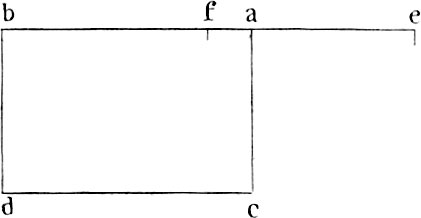
But in those which are longer than they are broad, it will be necessary from the length and breadth to seek for the height, that they may bear a proportion to each other. This height will be found in adding the breadth to the length, and dividing the whole into two equal parts, because one of those halves will be the height of the vault. As for example, let bc be the place to be arched; add the breadth, ac, to ab, the length, and let the line eb be made, which is to be divided into two equal parts, in the point f, we’ll say fb is the height we seek. Otherwise, let the room to be vaulted be twelve foot long and six abroad, add six to twelve, and it will make eighteen, the half of which is nine; the vault ought to therefore to be nine foot high.
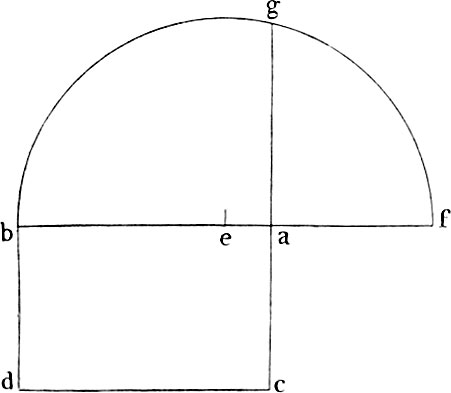
Another height, that will be proportionable both to the length and breadth of the room, will also in this manner be found. cb, the place to be vaulted, being set down, we’ll add the breadth to the length, and make the line bf; we’ll afterwards divide it into two equal parts in the point e, which being made the centre, we’ll make the half circle bgf, and lengthen ac until it touches the circumference in the point g, and ag will give the height of the vault cb.
By numbers it will thus be found: The length and breadth of the room in feet being known, we’ll find a number that has the same proportion to the breadth as the length as to the number sought. This we find a number that has the same proportion to the breadth as the length to the number sought. This we find by multiplying the lesser extreme with the greater; because the square root of the number which will proceed from the said multiplication, will be the height we seek. As for example, if the place that we intend to vault be nine foot long, and four wide, the height of the vault will be six foot; and the same proportion that has to six, six also has to four, that is the sesquialteral.
But it is to be observed, that it will not be possible always to find this height in whole numbers.
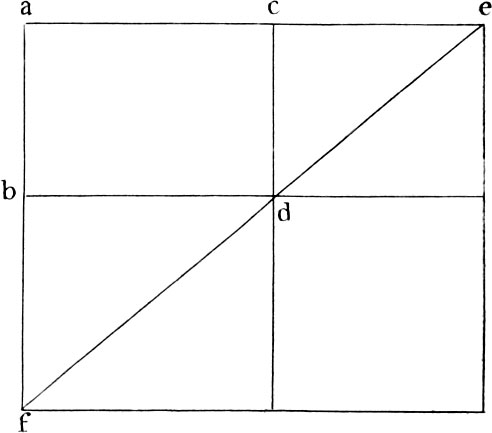
Another height may be found that will fall short of this, but nevertheless will be proportionable to the room. Draw the lines ab, ac, cd, and bd, that describe the breadth and length of the room, and the height will be found as in the first method, which is ce, this join to ac, then draw the line edf, and lengthen ab until it touches edf in the point f, and bf will be the height of the vault.
This may likewise be done with numbers. The height being found, from the length and breadth of the room, according to the first method (which in a foregoing example was nine) the length, breadth and height must be placed as they are in the figure; then nine is to be multiplied with twelve and with six, and that which will proceed from twelve is to be placed under the twelve, and the product of six under the six; afterwards the six is to be multiplied with twelve, and the product, which is seventy two, placed under the nine; then a number being found which multiplied by nine amounts to seventy two, which in our case would be eight, we’ll say eight foot to be the height of the vault.

These heights run in this manner between themselves, viz. the first is greater than the second and the second is greater than the third; we’ll however make use of each of these heights, according as they may suit with convenience, that several rooms of different dimensions may be so made as to have all their vaults of an equal height, and the said vaults to be nevertheless proportionable to them; from which will result both beauty to the eye, and convenience for the floors that are placed thereon, since they’ll all be level.
There are also other heights for vaults, which do not come under any rule, and therefore left for the architect to make use of as necessity requires, and according to his own judgement.
Chapter XXIV Of the several manners of vaults
There are six manners of vaults, viz. crossed, fasciated, flat (so they call vaults which are a portion of a circle, and to not arrive to a semicircle) circular, groined, and shell-like; all which are a third part of the breadth of the room in height.
The two last manners have been invented by the moderns, but the four first were used by the ancients.
The circular vaults are made in square rooms, and the manner of making them is thus: In the angles of the room are left some mutules that support the semicircle of the vault, which in the middle is flat, but more circular the nearer it comes to the angles.
There is one of this kind in the baths of Titus at Rome, which was partly ruined when I saw it.
I have here put under the forms of all these different manners, applied to the different shapes of the rooms.
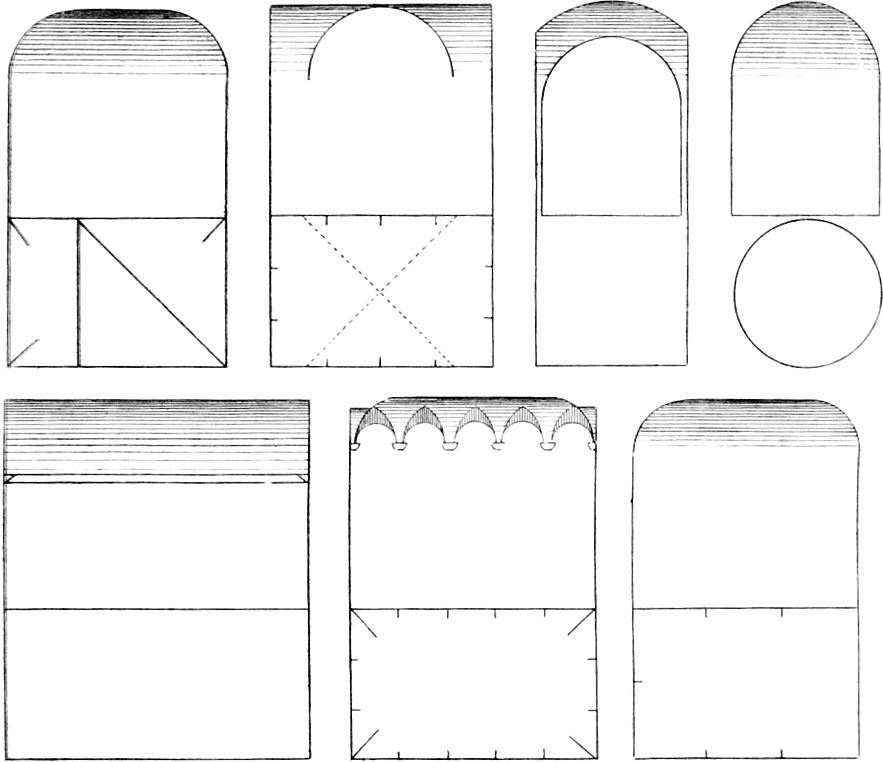
Chapter XXV Of the dimensions of the doors and windows
No certain and determinate rule can be given for the height and breadth of the principal doors of fabrics, or concerning the doors and windows of rooms; because, in making the principal doors, the architect ought to accommodate them to the bigness of the fabric, to the quality of the master, and to those things that are to be carried in and out of the same.
The best way, in my opinion, is to divide the space from the floor to the superficies of the joists, into three parts and a half, (as Vitruvius teacheth in the sixth chapter of his fourth book) and allow two to the height, and one to the breadth of the opening, wanting the twelfth part of the height.
The ancients used to make their doors narrower at the top than at bottom, as is seen in a temple at Tivoli, and which Vitruvius also teacheth, perhaps for greater strenghth.
The place to be chosen for principal doors, is where a free access may be had to it from all parts of the house.
The doors of rooms are not to be made wider than three foot, and six and a half high; nor less than two foot in breadth, and five in height.
It is to be observed in making the windows, that they should not take in more or less light, or be fewer or more in number, than what necessity requires: therefore great regard ought to be had to the largeness of the rooms which are to receive the light from them; because it is manifest, that a great room requires much more light to make it lucid and clear, than a small one: and if the windows are made either less or fewer than that which is convenient, they will make the places more obscure, and if too large, they will scarce be habitable, because they will let in so much hot and cold air, that the places, according to the season of the year, will either be exceeding hot or very cold, in case the part of the heavens which they face, does not in some manner prevent it.
Therefore the windows ought not to be wider than the fourth part of the breadth of the rooms, or narrower than the fifth, and are to be made two squares and a sixth part of their breadth more in height. And although the rooms in a house are made large, middling, and small, the windows, nevertheless, ought to be all equal in the same order or story.
To take the dimensions of the said windows, I like those rooms very much whose length is two thirds more than the breadth, that is, if the breadth be eighteen foot, the length should be thirty, and I divide the breadth into four parts and a half, one I give to the breadth of the void of the window, and two to the height, adding one sixth part of the breadth more; and according to the largeness of these I make those of the other rooms.
The windows above these, that is, in the second story, ought to be a sixth part less in the height of the void, than those underneath; and in the same manner, if other windows are placed higher, they ought to diminish still a sixth part.
The windows on the right hand ought to correspond to those on the left, and those above directly over them that are below; and the doors likewise ought to be directly over one another, that the void may be over the void, and the solid upon the solid, and all face one another, so that standing at one end of the house one may see to the other, which affords both beauty and cool air in the summer, besides other conveniences.
For greater strength, it is usual that the lintels or architraves of the doors and windows may not be overcharged with the weight, to make certain arches which are vulgarly called segments, which contribute very much to the duration of the fabric.
The windows ought to be distant from the angles or corners of the building, as has been said before, because that part ought not to be opened and weakened, which is to keep the whole edifice upright and together.
The pilasters or jambs of the doors and windows must not be less in thickness than the sixth part of the breadth of the void, nor more than the fifth.
It remains now that we look into their ornaments.
Chapter XXVI Of the ornaments of doors and windows
How the ornaments of the principal doors of a building ought to be made, may easily be known by what Vitruvius teacheth in the sixth chapter of the fourth book, (adding withal what the most reverend Barbaro says and shows in his design upon that subject) and by what I have hitherto said and designed in all the five orders.
But setting these aside, I shall only give some profiles of the ornaments of the doors and windows of rooms according as they may be differently made, and show how to mark each member in particular, that it may be graceful and have a due projection.
The ornaments given to doors and windows, are the architrave, frieze, and cornice: the architrave goes round the door, and must be as thick as the jambs and pilasters, (which I have said ought not to be less thick than the sixth part of the breadth of the void, nor thicker than the fifth)( from which also the frieze and cornice take their thickness.
The first or uppermost of the two designs which follow, has these measures: the architrave is divided into four parts, three of which are for the height of the frieze, and five for that of the cornice. The architrave is again divided into ten parts, three of which go to the first fascia, four to the second, and the remaining three parts are subdivided into five, two are given to the regolo or orlo, and the remaining three to the gola reversa, which is otherwise called intavolato. Its projection is equal to its height. The orlo projects less than half its thickness.
The intavolato is in this manner marked; a straight line must be drawn that ends at the extremities of that under the orlo, and upon the second fascia, and to be divided in the middle, making each of the halves the base of a triangle of two equal sides; then placing the fixed foot of the compasses in the angle opposite to the base, draw the curve lines which form the said intavolato.
The frieze is three parts of the four of the architrave, and is to be marked with a segment of a circle less than half a circle, and with its swelling comes directly to the cimacio of the architrave.
The five parts which are given to the cornice, are in this manner distributed to its members; one is given to the cavetto with its listello, which is a fifth part of the cavetto: the cavetto projects two parts in three of its height. To mark it a triangle must be formed of two equal sides, and the angle C made the center, so that the cavetto will be the base of the triangle: another of the said five parts is given to the ovolo, whose projection is two parts in three of its height; to mark it a triangle must be formed of two equal sides, and the point H made the center: the other three are divided into seventeen parts, eight are given to the corona or gocciolatoio, with its listelli, of which that above is one of the said eight parts, and that below which makes the hollow of the gocciolatoio, is one of the six parts of the ovolo: the other nine are given to the gola diritta, and to its orlo, which is one part of the three of the said gola. To form it well, and make it graceful, the straight line AB must be drawn, and divided into two equal parts, in the point C; one of these must be divided into seven parts, six of which must be taken to the point D, to form the two triangles AEC, and CBF, and in the points E and F the fixed foot of the compasses must be placed to describe the segments of a circle AC and CB, which form the gola.
The architrave likewise, in the second invention, is to be divided into four parts, three of which make the height of the frieze, and five that of the cornice.
The architrave must be divided into three parts, two of which must be subdivided into seven, and three given to the first fascia, and four to the second; the third part must be divided into nine; with two the tontino is made, and the other seven are to be subdivided into five, three of which form the intavolato, and two the ovolo.
The height of cornice is divided into five parts and three quarters, one of these must be divided into six, and five given to the intavolato over the frieze, and one to the listello; the projection of the intavoloato is equal to its height, as also of the listello. Another is given to the ovolo, whose projection is three parts of four of its height: the gradetto over the ovolo is a sixth part of the ovolo, and its projection the same: the other three are divided into seventeen, eight of which are given to the cocciolatoio, whose projection is four parts of three of its height; the other nine are divided into four, three of which are given to the gola, and one to the orlo: the three quarters that remain must be divided into five parts and a half; with one is made the gradetto, and with the other four and a half its intavolato over the gocciolatoio. The projection of this cornice is equal to its thickness.
The members of the cornice of the first invention.
- Cavetto
- Ovolo
- Gocciolatoio
- Gola
- Orlo
Members of the architrave.
- Intavolato or Gola reversa
- first Fascia
- second Fascia
- Orlo
- swelling of the Frieze
- part of the Frieze that goes into the wall
By means of these the members of the second invention may also be known.
Of these two other inventions, the architrave of the fist, marked with F, must likewise be divided into four parts; three and a quarter are given to the height of the frieze, and five to the height of the cornice. The architrave must be divided into eight parts, five go to the piano, and three to the cimacio; which is also divided into eight parts, three of which are given to the intavolato, three to the cavetto, and two to the orlo. The height of the cornice must be divided into six parts; two are given to the gola diritta with its orlo, and one to the intavolato; then the said gola must be divided into nine parts, with eight of which is made the gocciolatoio and gradetto: the astragal or tondino over the frieze, is a third of one of the said six parts, and that which remains between the gocciolatoio and tondino is left to the cavetto.
In the other invention the architrave marked with H, is divided into four parts; three and a half are given to the height of the frieze, and five to the height of the cornice: the architrave is divided into eight parts; five to the piano, and three to the cimacio: the cimacio is divided into seven parts; with one is made the astragallo, and what mains is divided again into eight parts, three are given to the gola reversa, three to the cavetto, and two to the orlo: the height of the cornice must be divided into six parts and three quarters; with three parts are made the intavolato, the dentello and ovolo. The projection of the intavolato is equal to its thickness; of the dentello two parts of three of its height, and of the ovolo three parts of four: with the three quarters the intavolato between the gola and gocciolatoio is made; and the other three parts are to be divided into seventeen, nine of which make the gola and orlo, and eight the gocciolatoio.
The projection of this cornice is equal to its height, as also the abovesaid cornices.
Chapter XXVII Of Chimneys
The ancients used to warm their rooms in this manner. They made their chimneys in the middle with columns or modiglions that supported the architraves, upon which was the pyramid of the chimney, from whence the smoke issued. There was one of these to be seen at Baie near Nero’s piscina, and another not far from Civita Vecchia.
And when they were not willing to have chimneys, they then made in the thickness of the walls and some tubes or pipes, through which they conveyed the heat of the fire that was under those rooms, and which came out of certain vents or holes that were made at the top of those pipes.
Almost in the same manner the Trenti, Vicentine gentlemen at Costoza, their villa cooled the rooms in the summer, because there are in the mountains of said villa some very large caves, which the inhabitants of those places called Couali, that formerly were quarries, (which I believe Vitruvius means, when in the second book, wherein he treats of stones, he says, that in the Barca Trivigiana a sort of stone was dug up, which was cut with a saw like wood) in which some very cool winds were generated, and which those gentlemen conveyed to their houses though certain subterraneous vaults, by them called ventiducts, and with pipes like the abovesaid, they convey that cool wind through all the rooms, by stopping and unstopping them at pleasure, to receive more or less of that cool air according to the seasons.
And although this very great convenience makes this place wonderful, what makes it still more worthy our admiration, is the prison of the winds, which is a subterraneous room built by the most excellent Signor Francesco Trento, and by him called Eolia, where a great number of those ventiducts discharge themselves; to beautify which, and make it worthy of the name, he has neither spared cost or care.
But to return to the chimneys; we make them in the thickness of the walls, and raise their tunnels above the roofs, that they may carry the smoke into the air: observing not to make their funnels to wide, nor too narrow; because if they are made wide, the air wandering through them, will drive the smoke down, and hinder its ascending and going out freely; when too narrow, the smoke not having a free passage, will choke it up, and return.
Therefore in the chimneys of rooms the funnels are not to be made less wide than half a foot, nor wider than nine inches, and two foot and a half long; and the mouth of the pyramid, where it joins to the funnel, must be made a little narrower, that the smoke returning down, may meet with that impediment to hinder its coming into the room.
Some make the funnel crooked, in order that by this crookedness, and the force of the fire, which drives the smoke up, they may prevent the smoke from returning back.
The top of the chimneys, or the holes through which the smoke is to go out, ought to be wide, and far from any combustible matter. The mantle-trees upon which the pyramid of the chimneys are made, ought to be very neatly wrought, and in everything far from being rustic; because rustic work is not proper, unless it be in very great edifices, for the reasons already mentioned.
Chapter XXVIII Of stairs, and the various kinds of them; and of the number and size of the steps
Great care ought to be taken in the placing of staircases, because it is no small difficulty to find a situation fit for them, and that doth not impede the remaining part of the fabric: A proper place must therefore be principally given to them, that they may not obstruct other places, nor be obstructed by them.
Three openings are required in staircases; the first is the door through which one goes up to the staircase, which the less it is hid to them that enter into the house, so much the more it is to be commended. And it would please me much, if it was in a place, where before that one comes to it, the most beautiful part of the house was seen; because it makes the house (although it should be little) seem very large; but however, let it be manifest, and easily found. The second opening is the windows that are necessary to give the light to the steps; they ought to be in the middle, and high, that the light may be spread equally everywhere alike. The third is the opening through which one enters into the floor above; this ought to lead us to ample, beautiful, and adorned places.
The staircases will be commendable if they are clear, ample, and commodious to ascend, inviting, as it were, people to go up: They will be clear, if they have a bright light, and if (as I said) the light be diffused equally everywhere alike: They will be sufficiently ample, if they do not seem scanty and narrow to the largeness and quality of the fabric; but they are never to be made less wide than four foot, that if two persons meet, they may conveniently give one another room: They will be convenient with respect to the whole building, if the arches under them can serve to lodge some necessities; and with respect to men, if their ascent is not to steep and difficult: therefore their length must be twice their height.
The steps ought not to be made higher than six inches of a foot; and if they are made lower, particularly in long and continued stairs, it will make them the more easy, because in rising one’s self the foot will be less tired; but they must never be made lower than four inches: the breadth of the steps ought not to be made less than one foot, nor more than one and a half.
The ancients observed to make the steps uneven in number, that beginning to go up with the right foot, one might end with the same; which they looked upon as a good omen, and of greater devotion when they entered the temple: The number of steps is not to exceed eleven, or thirteen at most, before you make a floor or resting-place, that the weak and weary may find where to rest themselves, of obliged to go up higher, and be able more easily to stop anything that should happen to fall from above.
Staircases are either made straight or winding; the straight are either made to spread into two branches, or square, which turn into four branches: To make these, the whole places is to be divided into four parts, two are given to the steps, and two to the void in the middle, from which these stairs would have light, if it was left uncovered: They may be made with the wall within, and then in the two parts which are given to the steps, this wall is also included; and they may also be made without.
These two sorts of staircases were invented by the magnificent Signor Luigi Cornaro, a gentleman of an excellent judgement, as may be known by the most beautiful loggia, and the most elegantly adorned rooms which he built for his habitation at Padua.
The winding staircases (that are also called a chiocciola) are in some places made round, in others oval, sometimes with a column in the middle, and sometimes void, in narrow places particularly, because they occupy less room than the straight, but are somewhat more difficult to ascend. They succeed very well that are void in the middle, because they can have the light from above, and those that are at the top of the stairs, see all those that come up, or begin to ascend, and are likewise seen by them: Those that have a column in the middle, steps, and one given to the column, as in the design A, or let the diameter be divided into seven parts, and three given to the column in the middle, and four to the steps; and in this manner exactly is made the staircase of the column of Trajan. And if the steps are made crooked, as in the design B, they will be very beautiful to look at, and longer than if they are made straight: but in those that are void, the diameter must be divided into four parts; two are given to the steps, and two remain for the place in the middle.
Besides the usual manners of stairs, there was another sort of winding staircase invented by the Clarissimo Signor Marc’ Antonio Barbaro, a Venetian gentleman of a fine genius, by which in very narrow places serves very well: it has no column in the middle; and because the steps are crooked, they are very long, and must be divided as the abovesaid.
The oval staircases are also divided in the very same manner as the round; they are very beautiful and agreeable to see, because all the windows and doors come to the head of the oval, and in the middle, and are sufficiently commodious.
I have made a staircase void in the middle, in the monastery de la Carita in Venice, which succeeds admirably.
- The winding staircase with a column in the middle
- The winding staircase with a column, and with crooked steps
- The winding staircase void in the middle
- The winding staircase void in the middle, and with crooked steps
- The oval staircase with the column in the middle
- The oval staircase without a column
- The straight staircase with the wall within
- The straight staircase without the wall
Another beautiful sort of winding stairs was made at Chambor, (a place in France, by order of the magnanimous King Francis, in a palace by him erected in a wood, and is in this manner: there are four staircases, which have four entrances, that is, one each, and ascend the one over the other in such a manner, that being made in the middle of the fabric, they can serve to four apartments, without that the inhabitants of the one go down the staircase of the other, and being open in the middle, all see one another going up and down, without giving one another the least inconvenience: and because it is a new and beautiful invention, I have inserted it, and marked the staircases with letters in the plan and elevation, that one may see where they begin, and how they go up.
There were also in the porticos of Pompey in Rome, going into the piazza Giudea, three winding staircases of a very laudible invention, because being placed in the middle, where they could receive no light but from above, they were made upon columns, that the light might spread equally everywhere.
In imitation of these, Bramante, a most excellent architect in his time, made one in Belvedere without steps, and with the four orders in architecture, that is, the Doric, Ionic, Corinthian and Composite. To make such staircases, the whole space is to be divided into four parts; two are given to the void in the middle, and one of a side to the steps and columns.
Many other sorts of staircases are to be seen in ancient edifices, such as triangular; of this kind are the stairs that lead to the cupulo of Santa Maria Rotonda, and are void in the middle, and receive the light from above. Those were also very magnificent that are at Santo Apostolo in the said city, and go up to Monte Cavallo: those staircases were double, from which many have since taken example, and did lead to a temple placed on the top of the mountain, as I shall show in my book of temples; and the last design is of this sort.
Chapter XXIX Of Roofs
The walls being said raised up to their summit, the vaults made, the joists of the floors laid, the staircases, and all those things accommodated of which mention has been made before, it is necessary to make the roof; which embracing every part of the fabric, and with its weight pressing equally upon the walls, is a kind of ligament to the whole work, and besides defending the inhabitants from rain, snow, the scorching sun, and moisture of the night, it is no small assistance to the fabric, in casting off the water from the water from the walls when it rains, which although they may seem to be but of little prejudice, are, nevertheless, in time the cause of great damages.
Our forefathers (as may be read in Vitruvius) used to make the roofs of their habitations flat; but perceiving that they were not sheltered from rain, compelled by necessity, began to make them rigid, or raised in the middle.
These ridges ought to be made higher or lower, according to the regions where one builds; therefore in Germany, by reason of the great quantity of snow that falls there, the roofs are made very acute, and covered with shingles, which are small pieces of boards, or with very thin tiles; which roofs, if they were otherwise made, would be destroyed by the weight of the snow: But we that live in temperate regions, ought to choose that height which makes a roof appear agreeable and with a beautiful form, and that easily carries off the rain.
Therefore the breadth of the place to be roofed, must be divided into nine parts, and two given to the height of the ridge; for if it is made with a fourth of the breadth, the roof will be too steep, whereby the tiles will be fastened with great difficulty; and if a fifth is given, it will be too flat, and therefore the tiles and shingles would be very much charged when the snows fall.
Gutters are usually made round the houses, into which the water falling from the tiles, is by spouts thrown away a great distance from the walls: these ought to have a foot and a half of wall over them, which, besides holding them firm, will defend the timber of the roof from receiving damage in any part from the water.
There are various manners of disposing the timber of the roofs; but when the middle walls support the beams, they are very easily accommodated; which method pleaseth me very much, because the out-walls do not bear so much weight, and although the head of some beam should rot, the roof is notwithstanding in no danger.
